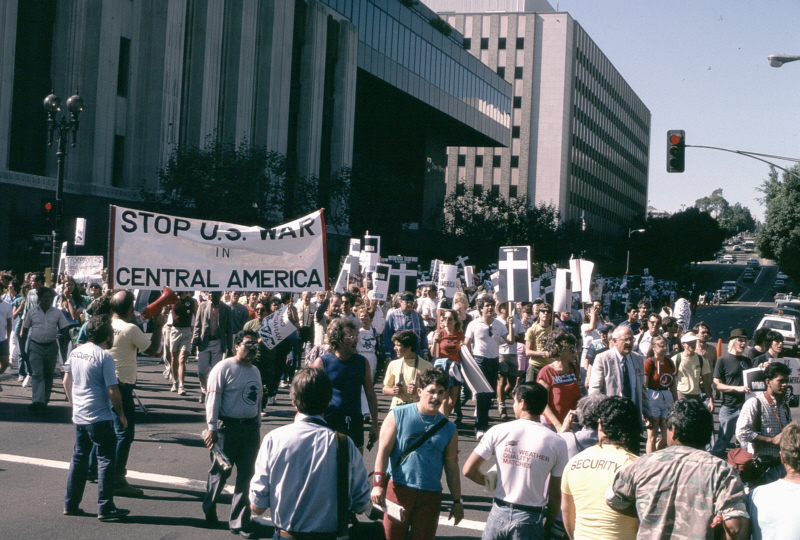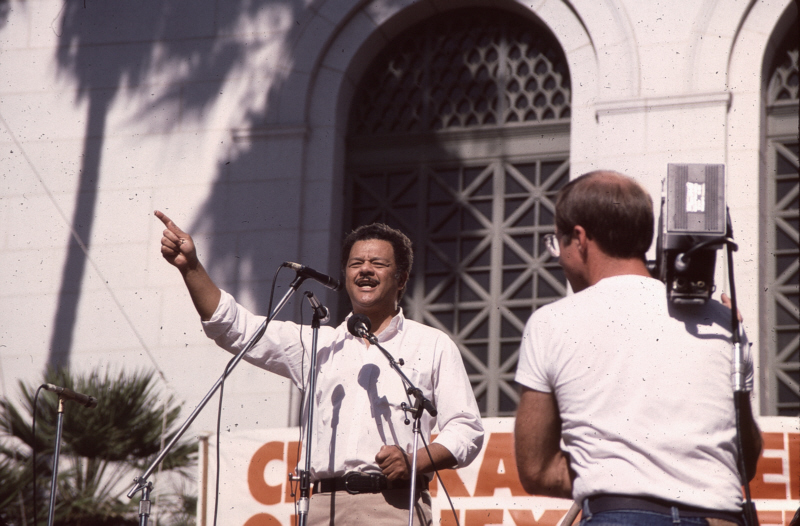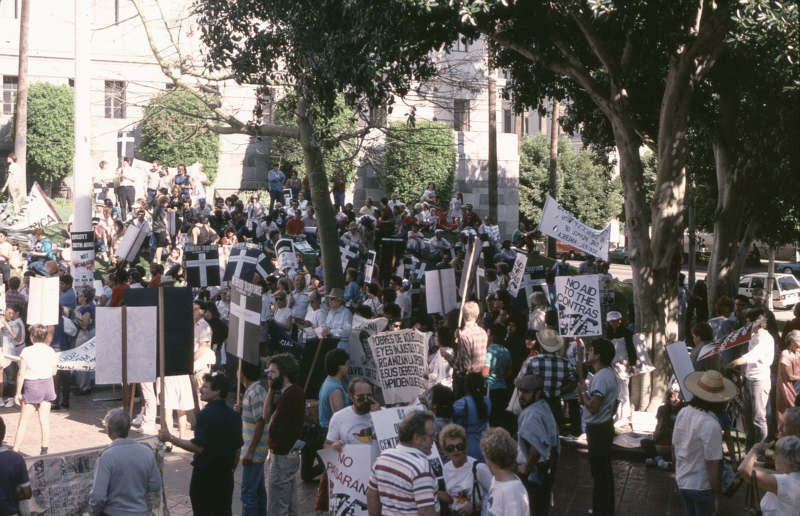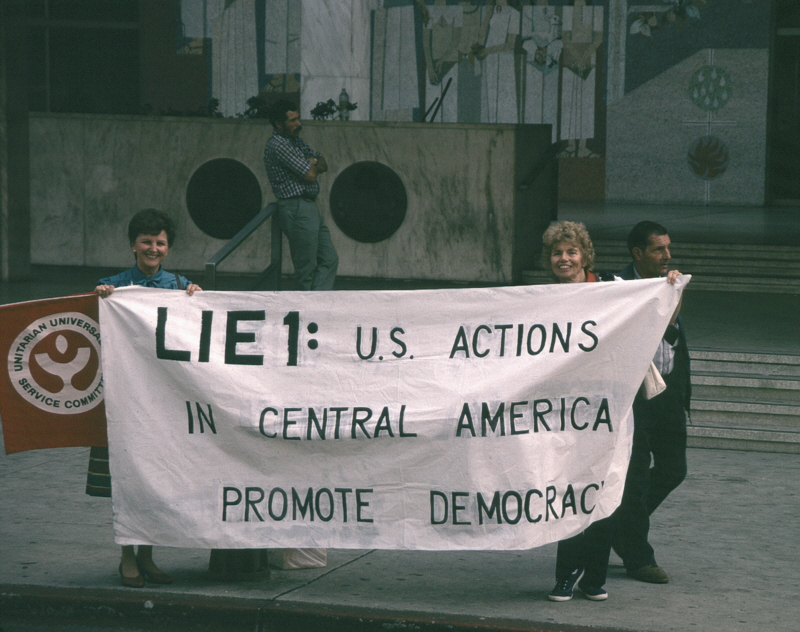 Fall, 1986.
Emerson Unitarian Universalist Church member Carroll Trumbull, and UUSC staffer Fiona Knox in front of the Federal Building,
downtown Los Angeles. I doubt that here they were part of the large demonstration of November 1, as shown in the following photos.
Fall, 1986.
Emerson Unitarian Universalist Church member Carroll Trumbull, and UUSC staffer Fiona Knox in front of the Federal Building,
downtown Los Angeles. I doubt that here they were part of the large demonstration of November 1, as shown in the following photos.
The Unitarian Universalist Service Committee has a long and
honorable history in the struggle for human rights and social justice. The Southern California Chapter
was a joy to work with.
1986 was an important year for the anti-intervention movement, and the demonstration shown in the next bloc of pictures
was perhaps the most important ever to take place in the Los Angeles area. Quotes and details in the prefatory comments
that follow are from various Los Angeles Times (LAT) articles that I still have in my files.
In June 1985, Congress had approved $27 million in "humanitarian" aid to the contras, but also forbade the CIA from any
role in distributing it. The CIA was allowed to provide the contras with "humanitarian" intelligence on
Sandinista troop strength and movements, however. The House also "rejected, 254 to 174, a Democratic alternative by Reps.
Lee Hamilton (D-Ind.) and Michael D. Barnes (D-Md.) that would have provided $14 million in aid to Nicaraguan
refugees rather than the contras." (House Approves Funds for Contras Aid Bill Passes Easily in Major Reagan Victory,
June 13, 1985.)
1986 began with a 253-182 Democratic majority in the House of Representatives,and a 53-47 Republican majority in
the Senate. Early in the year, president Reagan asked Congress for $100 million in economic and military aid to
the atrocity-prone Nicaraguan contras, whom he had famously referred to as the "moral equivalents of America's
founding fathers."
In spite of this pedigree, Congress had prohibited military aid to the contras since 1984, when it was learned that
the CIA had mined Nicaragua's harbors and sent its hired operatives into battle — without informing Congress. (One naturally
suspects, but cannot prove, that had the CIA been more forthcoming, and informed the House and Senate Intelligence Committees of its plan
to blow up the ships of nations doing business with Nicaragua — several European nations included — the lawmakers
would have said "ok.")
Reagan sensed that by stepping up the rhetoric casting opponents of aid as communist sympathizers, he could eventually
bend them to his will. Still, in early 1986, Reagan's shrill tone had offended moderate Republicans such as
Senator Nancy Kassenbaum (R-Kan), who found the President's "simplistic reasoning highly offensive." Kassenbaum also
said that she and two other moderate Republican Senators "could not support the bill in its present form." (Reagan Under Fire
for Partisan Line on Contras; LAT, March 7, 1986.)
But, unlike the other two Senators, Kassenbaum succumbed to the Magic Salesman's charms just three weeks later, when she voted
with the 53-47 majority to approve Reagan's $100 million contra aid request. 11 Democrats, all but two from southern states,
voted for the aid, and 11 Republicans, all from northern states, voted against the aid. The Democratic-controlled House
barely rejected the request a week earlier. (Senate Approves
$100-million Aid Plan for Contras; LAT, March 28, 1986.)
I refer to Reagan as the "Magic Salesman" advisedly. He was a master at pushing the American people's fear buttons,
and his avuncular manner reassured them that he was the only person standing between them and annihilation. Democratic
lawmakers understood this magical power, and thus were always on the verge of caving.
As Republican Rep. Guy Vander Jagt put it: "Democrats live in holy terror that the President will go on the tube and lambaste them for a vote.
They live in fear of his communicative ability."
On the other hand, straight-out, old-fashioned bribery also works:
"If you want a bridge in your district, if you want the Secretary of Agriculture to appear
in your district, it's yours," [Rep. Michael Barnes (D-Md.)] said. "Anything you want from this
administration ... now's the time to get it." (Democrats Swinging Over to Reagan's Contras Stand; LAT, April 15, 1986.)
And it all worked; on June 25, three months after Senate approval, the House caved and gave Reagan the $100 million he wanted.
The vote was 221-209, with 51 Democrats voting with the majority and 11 Republicans opposing the aid package. California lawmakers
voted along strict party lines.
Opponents of military aid tried,
with and without success, to impose restrictions on the aid: the House passed an amendment to the bill "prohibiting U.S. government personnel
— including military trainers — in neighboring countries from venturing within 20 miles of the Nicaraguan border." This
because lawmakers feared the kind of slippery slope that led to the Vietnam debacle. And, because the contras had been accused of
misappropriating their previous funds, an amendment was offered and defeated requiring an accounting of past allocations
before the $100 million would be released. (Arms Aid for Contras Wins House Approval; LAT, June 26, 1986.)
The World Court agreed with the grass-roots opposition to Reagan's policies. On June 27, the International Court of
Justice ruled that Reagan had broken international law, and called upon the administration to cease its support for
the contras and also to compensate Nicaragua for the damage that the contras had inflicted. Among its 16 findings,
the court ruled against the U.S. assertion that support for
the contras was necessary for the "collective defense" of the hemisphere.
The single U.S. judge on the court dissented on 12 of the 16 findings. Reagan thumbed his nose at the
court, of course. (World Court Rules U.S. Aid to Contras Is Illegal; LAT, June 28, 1986.)
On August 13, after reconciling with the House version of the aid package, the Senate gave its approval.
Because the contras had been accused of drug trafficking and human rights abuses, Senator Patrick Leahy
(D-Vt.) offered an amendment prohibiting all CIA involvement in the war. '"I think it's an
impossible situation" Leahy said. "Don't send them down into a sordid little war where they get tarnished
with everybody else."' Leahy's amendment was defeated, paving the way for open and,
except inside Nicaragua itself, unhindered CIA-contra collaboration. (I suggest that what to Leahy would
be "tarnish," the CIA spooks would call "luster.")
(Contras Aid Gets Senate Approval; LAT, August 14, 1986.)
Then, on October 5th, a Sandinista soldier shot down a contra supply plane using a Soviet-made
shoulder-fired rocket and things really got interesting. The pilot, William Cooper; co-pilot, Wallace Sawyer, both Americans;
and Nicaraguan radio operator Freddy Vilches all died in the crash. Eugene Hasenfus, an out-of-work-steelworker from Marinette, Wisconsin,
was the "kicker," whose job it is to kick the supplies from the plane's open cargo door. Apparently,
Hasenfus was not as sure as were Sawyer and Cooper that they were invulnerable to harm in
this illegal contra supply operation; he jumped to safety using a parachute he had borrowed from his brother several weeks earlier.
He was captured the next day.
Hasenfus was described by his aunt as "a good, jolly person and helpful in anyway he could be." "He has ... the
greatest smile you would ever want to see," she added. (Downed Plane Not Ours, Shultz Says; Survivor
an Ex-Marine and Sky diver; LAT, October 8, 1986.)
But, the Eugene Hasenfus shown
being led into captivity by two Sandinista soldiers did not look particularly jolly. "... a [Nicaraguan]
radio announcer, unable to hide his enthusiasm, described the captured man as 'tall, blond
and strong, just like one always imagined a pure gringo would be.'" On October 11, Mike Wallace
interviewed Hasenfus in his cell for the CBS program 60 Minutes.
(Hasenfus: Nothing But the Fact, Envío Digital; Number 65,
November 1986.)
News coverage for the next three weeks focused on whether the
Sandinistas would put Hasenfus on trial; extensive analyses of the evidence found at the scene;
Hasenfus's own statements; and what would be his punishment if he were tried and found guilty. The administration
denied any connection with the operation, saying it was a civilian effort to keep the contras alive until
congress approved funding for them. But, the operation had all the earmarks of CIA operation hidden
beneath thick layers of civilian camoflauge.
On October 29, the Sandinista prosecutor formally charged Hasenfus with terrorism,
violation of the law on public order and security, and illicit association for criminal purposes. If found guilty
by the revolutionary tribunal, he could be sentenced to 30 years in prison.
(Nicaragua Prosecutor Opens Case Against American; LAT, October 30, 1986.)
This was the overall situation on November 1, 1986, when some 5000-8000 peace activists walked through downtown
Los Angeles to protest President Reagan's war. (Thousands Protest U.S. Support of the Contras; LAT, November 2, 1986.)
More details below.
|
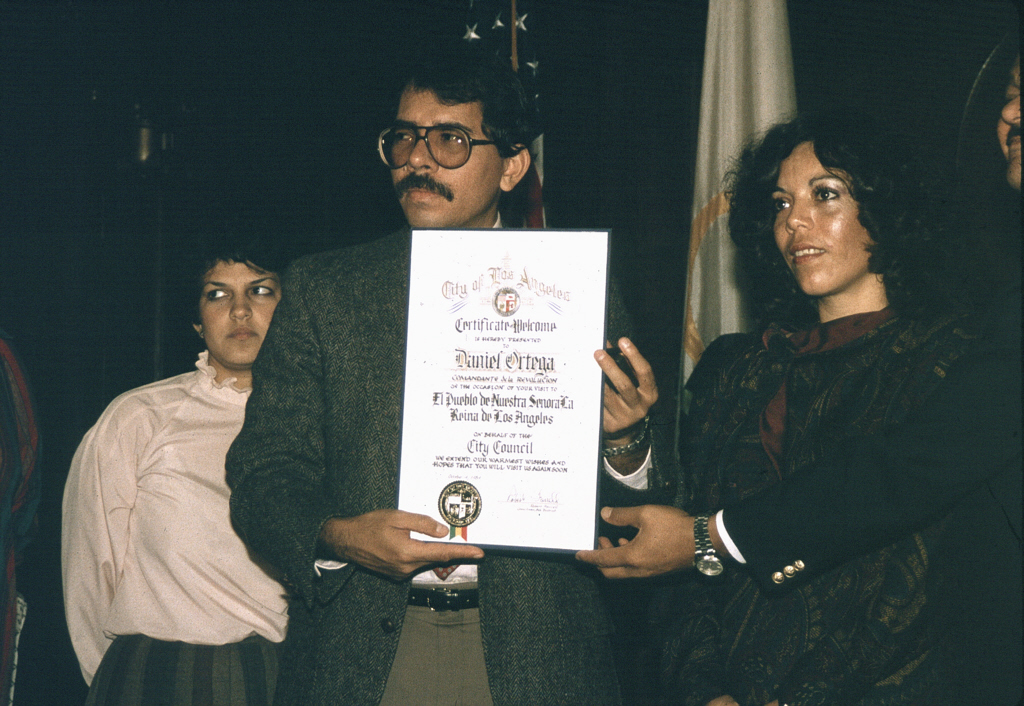 October 4, 1984. The office of Mayor Tom Bradley, City of Los Angeles.
Sandinista President of Nicaragua, Comandante de la Revolución Daniel Ortega and his wife, poet Rosario Murillo. A Nicaraguan translator
stands behind them, looking somewhat skeptical about the whole proceeding.
October 4, 1984. The office of Mayor Tom Bradley, City of Los Angeles.
Sandinista President of Nicaragua, Comandante de la Revolución Daniel Ortega and his wife, poet Rosario Murillo. A Nicaraguan translator
stands behind them, looking somewhat skeptical about the whole proceeding.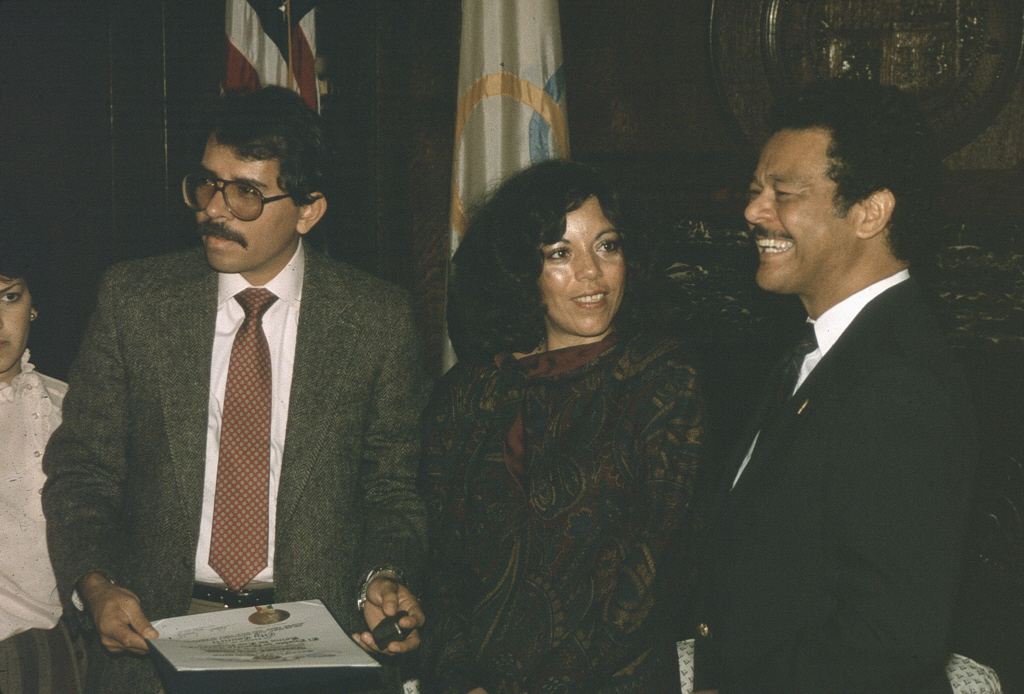 Rosario Murillo has apparently just told Counciman Farrell a funny joke.
Rosario Murillo has apparently just told Counciman Farrell a funny joke.
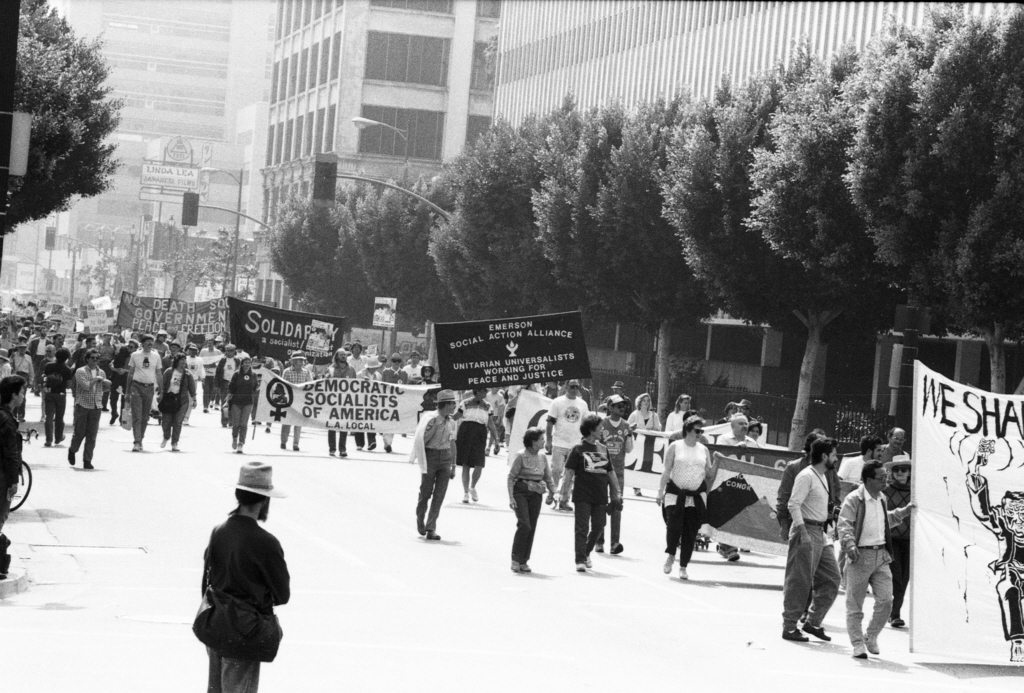 South Broadway, downtown Los Angeles. My best guess is that this large demonstration
took place in 1990. The Emerson Social Action Alliance was comprised of members of
South Broadway, downtown Los Angeles. My best guess is that this large demonstration
took place in 1990. The Emerson Social Action Alliance was comprised of members of 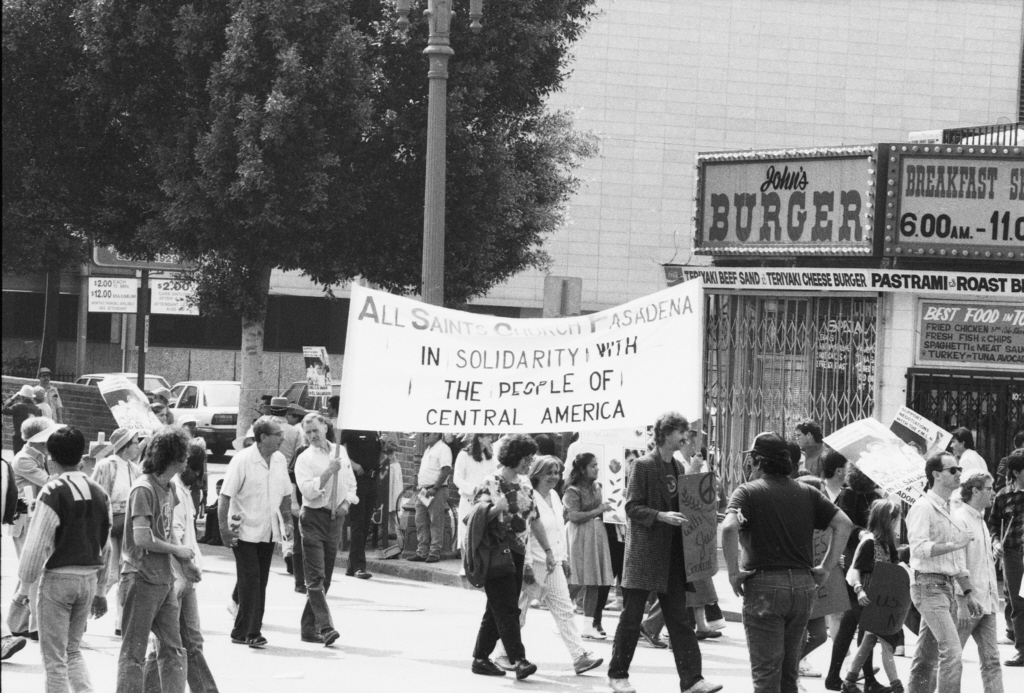 All Saints Episcopal Church in Pasadena. Not the kind of church that
the Reagan Administration liked.
All Saints Episcopal Church in Pasadena. Not the kind of church that
the Reagan Administration liked.
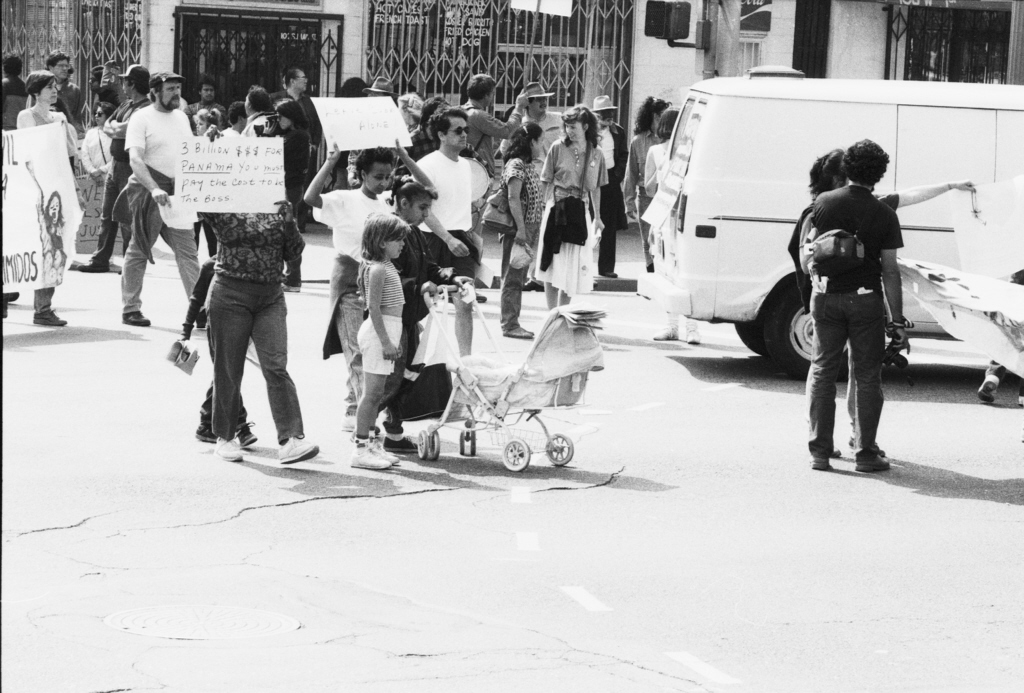
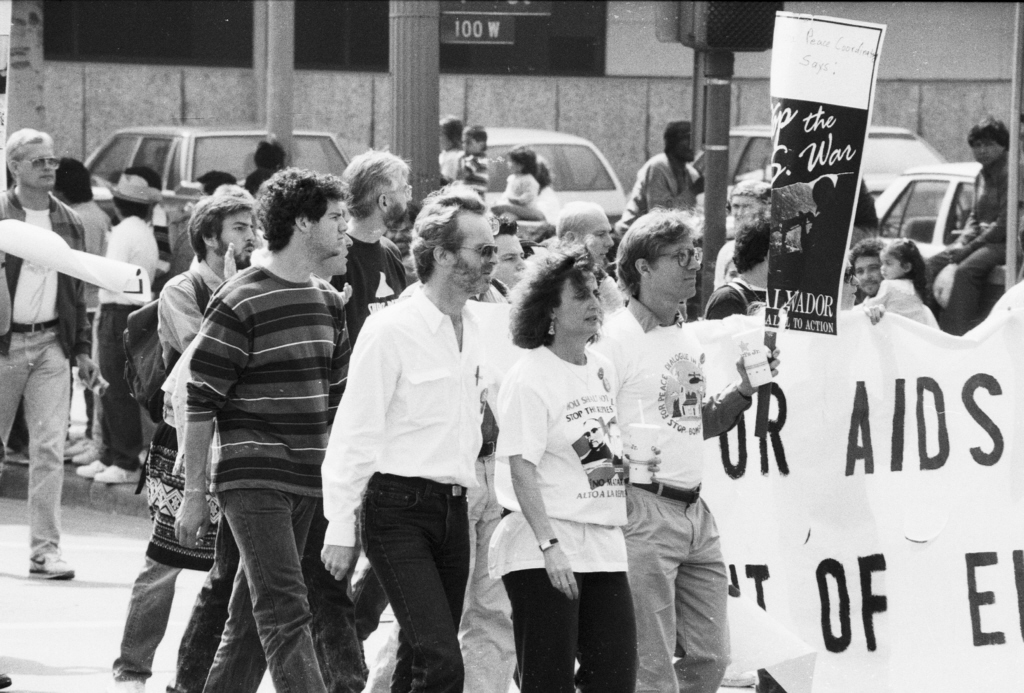 Actor David Clennon, center, in dark glasses and beard,
was a tireless anti-intervention worker.
Actor David Clennon, center, in dark glasses and beard,
was a tireless anti-intervention worker.
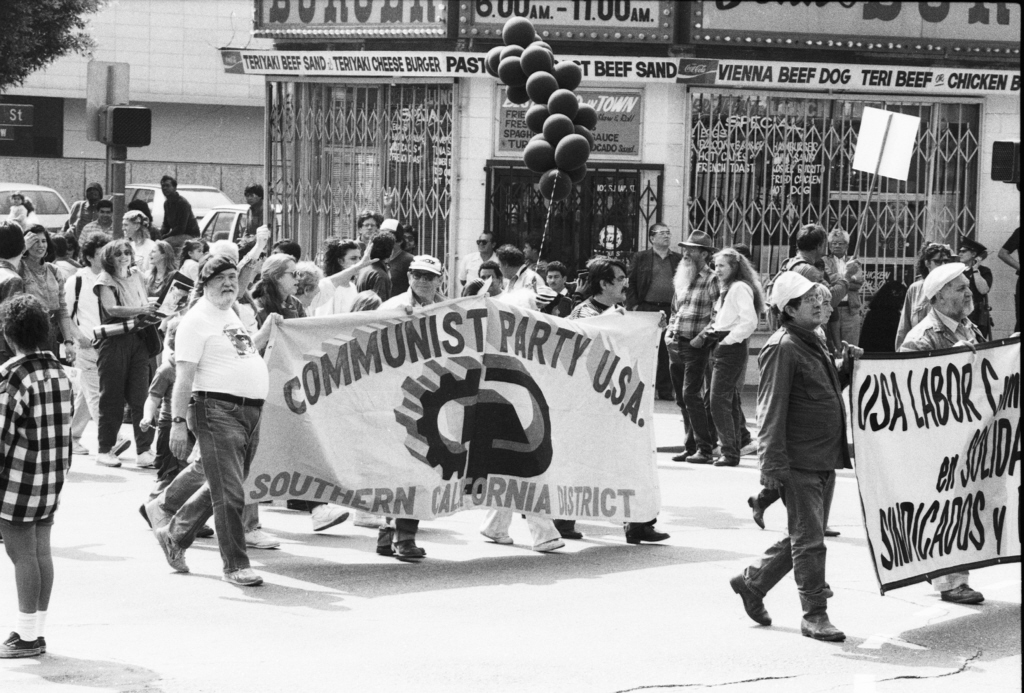 The banner that drives red-blooded patriots up the wall. The gentleman in the beret
eyes me suspiciously, probably from long experience with police photographers.
The banner that drives red-blooded patriots up the wall. The gentleman in the beret
eyes me suspiciously, probably from long experience with police photographers.
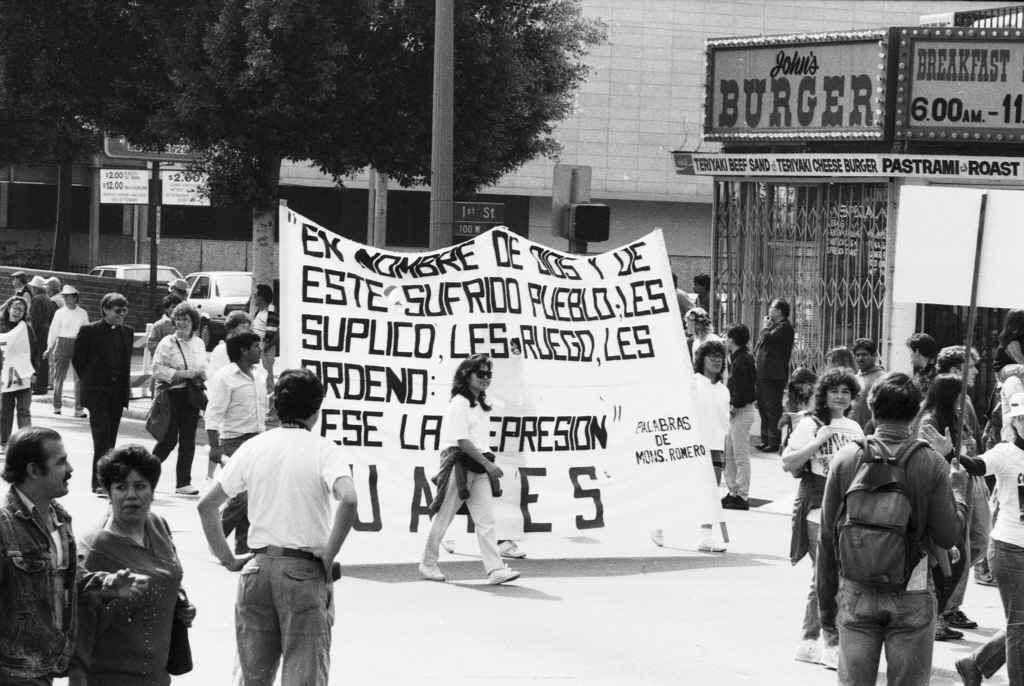 An abbreviation of the last words of El Salvador's Archbishop Oscar Romero, spoken to the members of
El Salvador's repressive military apparatus in his homily of March 24, 1980:
An abbreviation of the last words of El Salvador's Archbishop Oscar Romero, spoken to the members of
El Salvador's repressive military apparatus in his homily of March 24, 1980:
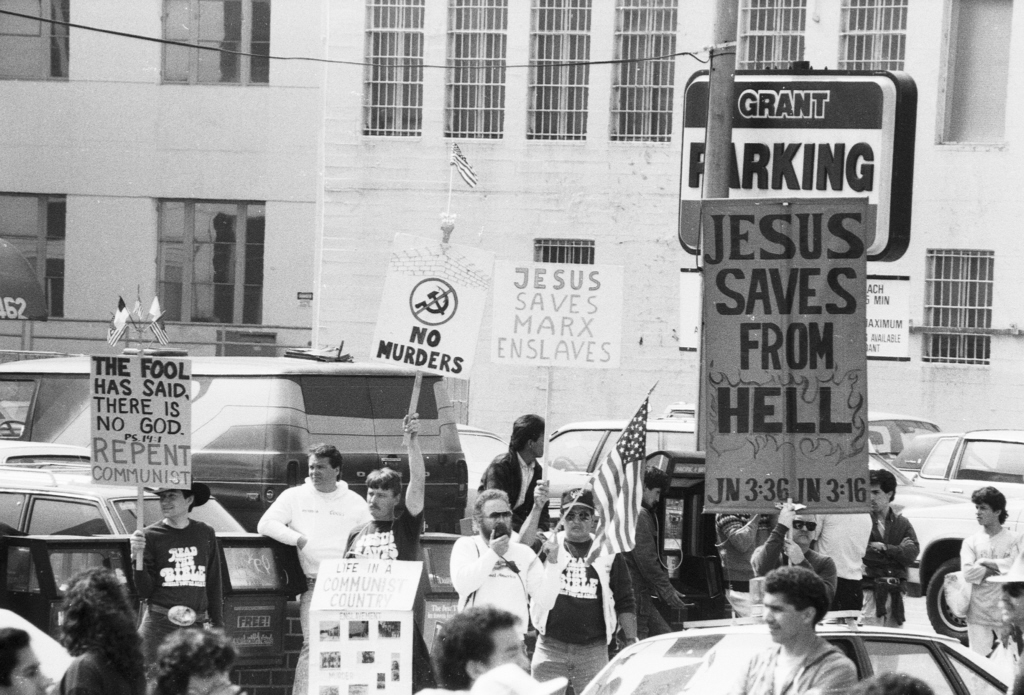 I doubt that the "no murders" placard was intended to refer to
Latin American advocates for the poor like Archbishop Romero.
I doubt that the "no murders" placard was intended to refer to
Latin American advocates for the poor like Archbishop Romero.
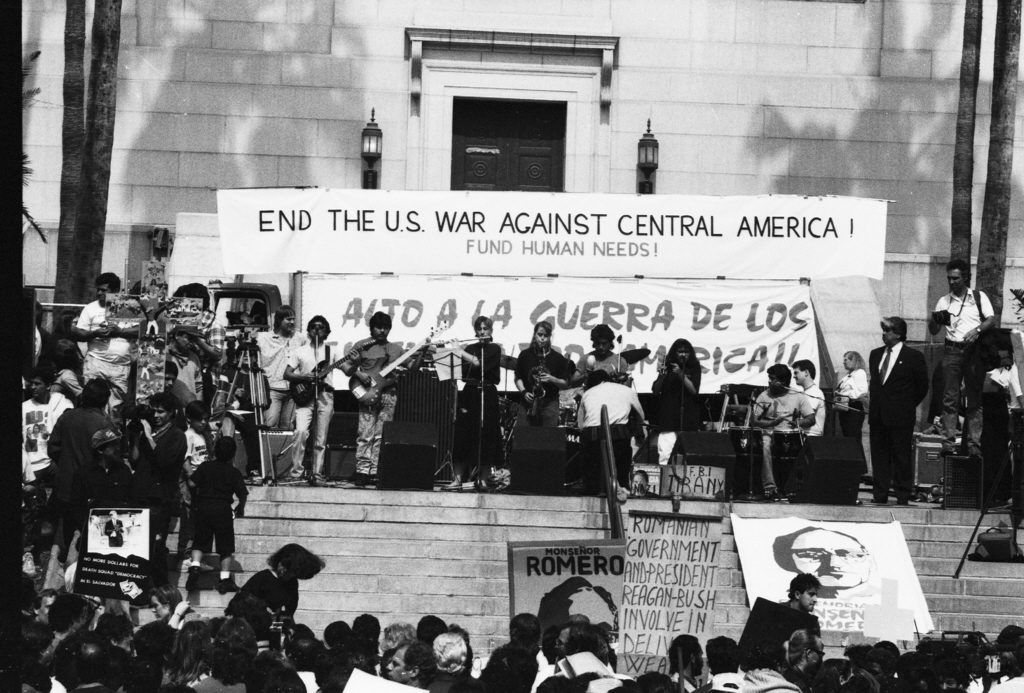 We have reached our destination: the south lawn of Los Angeles Old City Hall. No demonstration
is complete without music. The following photos give an idea of the size of the demonstration, and
of the wide variety of posters and
banners created to express our rage at the Reagan administration.
We have reached our destination: the south lawn of Los Angeles Old City Hall. No demonstration
is complete without music. The following photos give an idea of the size of the demonstration, and
of the wide variety of posters and
banners created to express our rage at the Reagan administration.
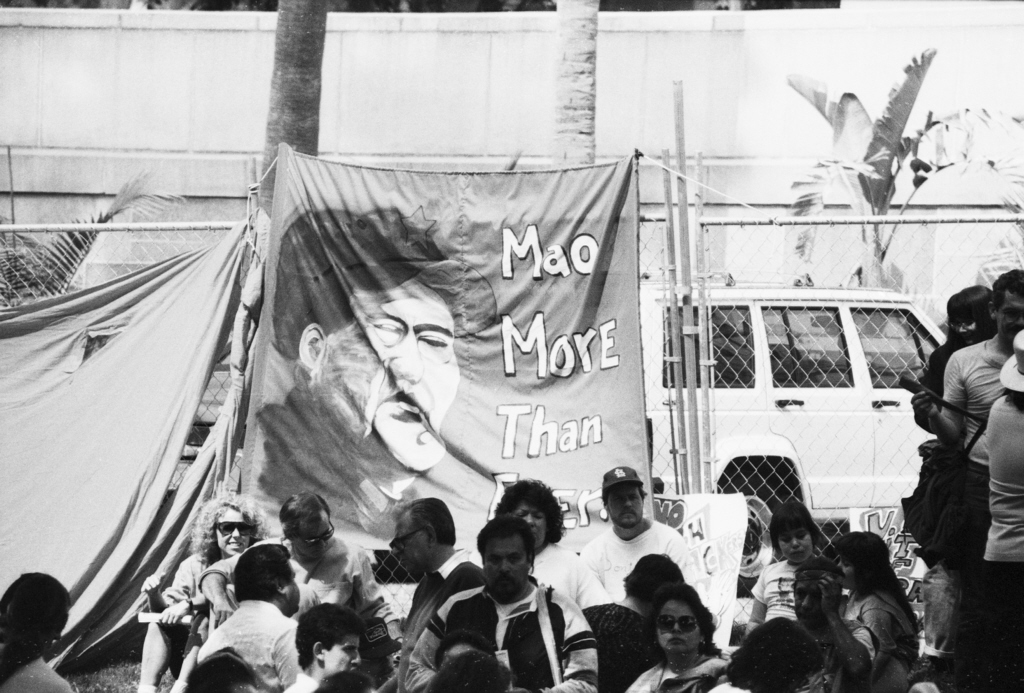
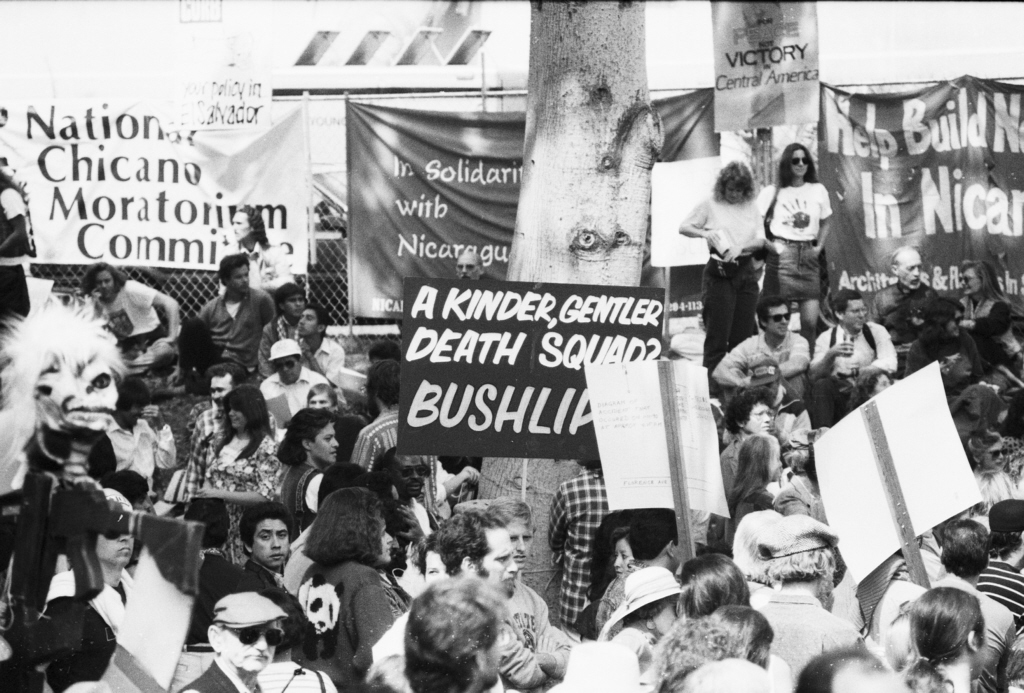
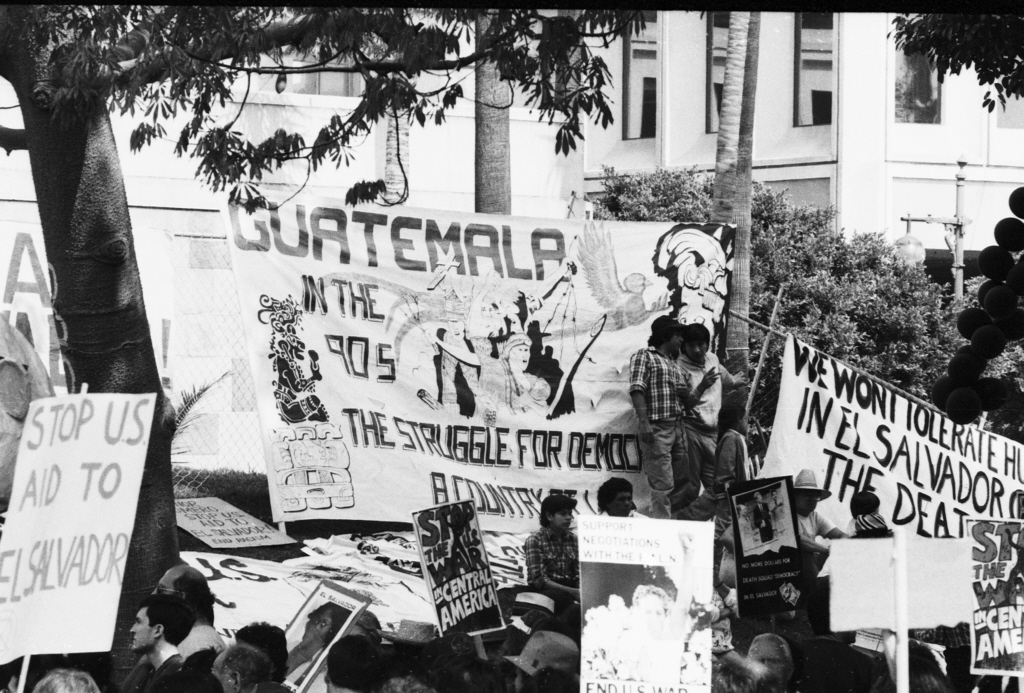
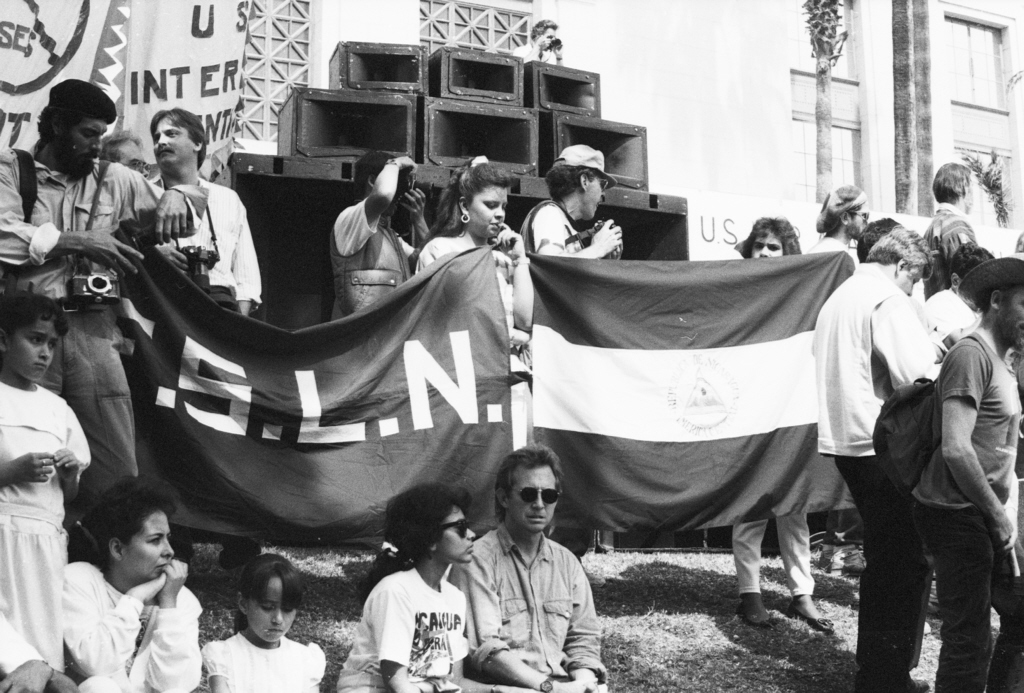
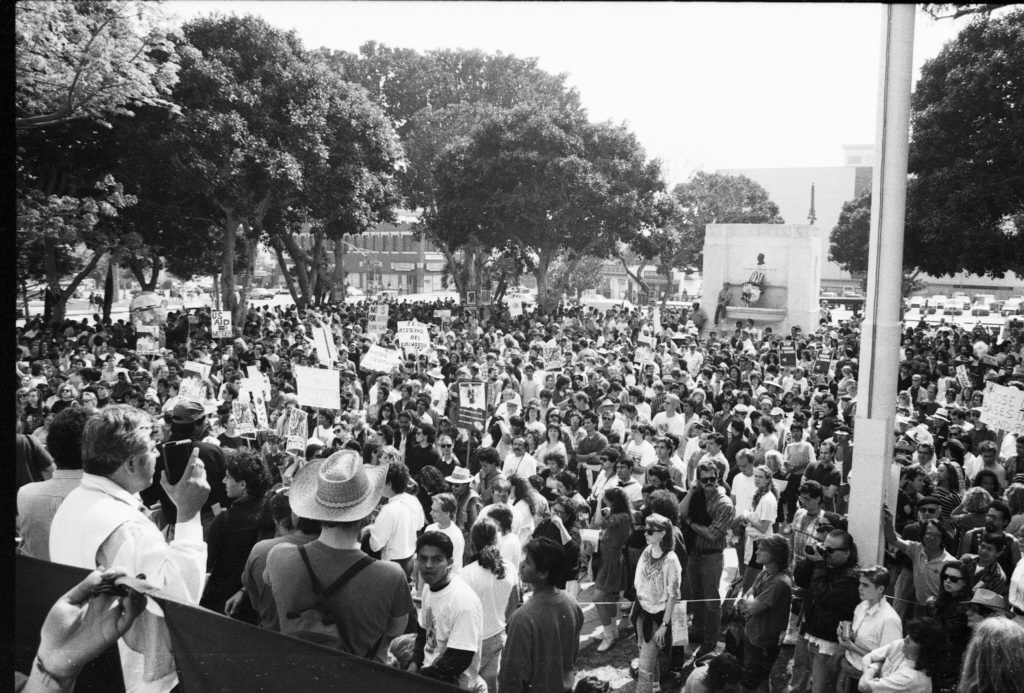
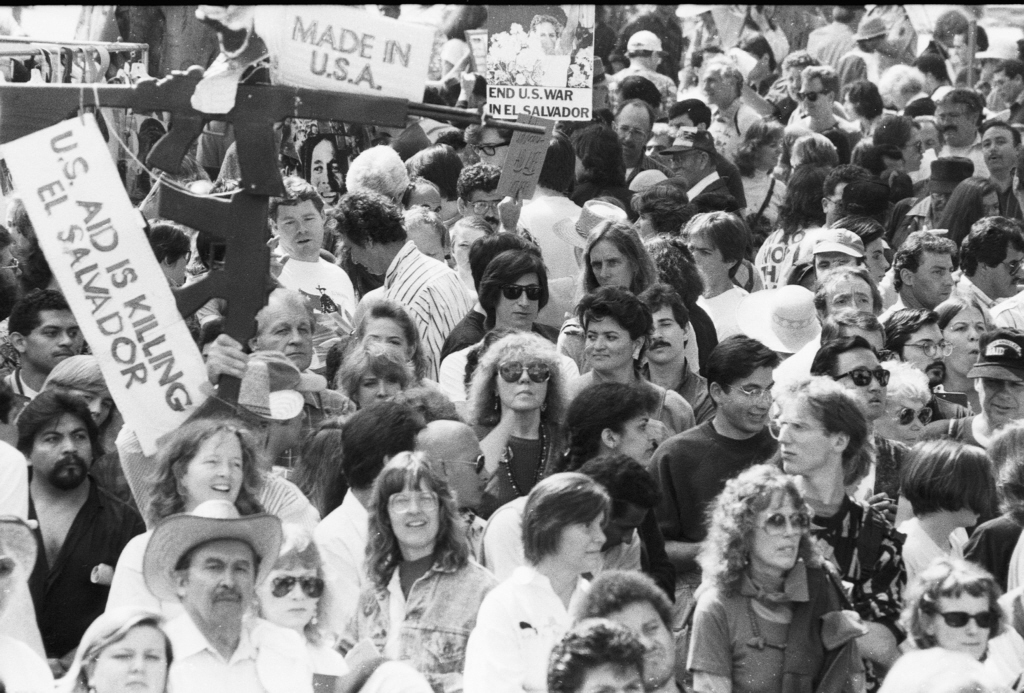
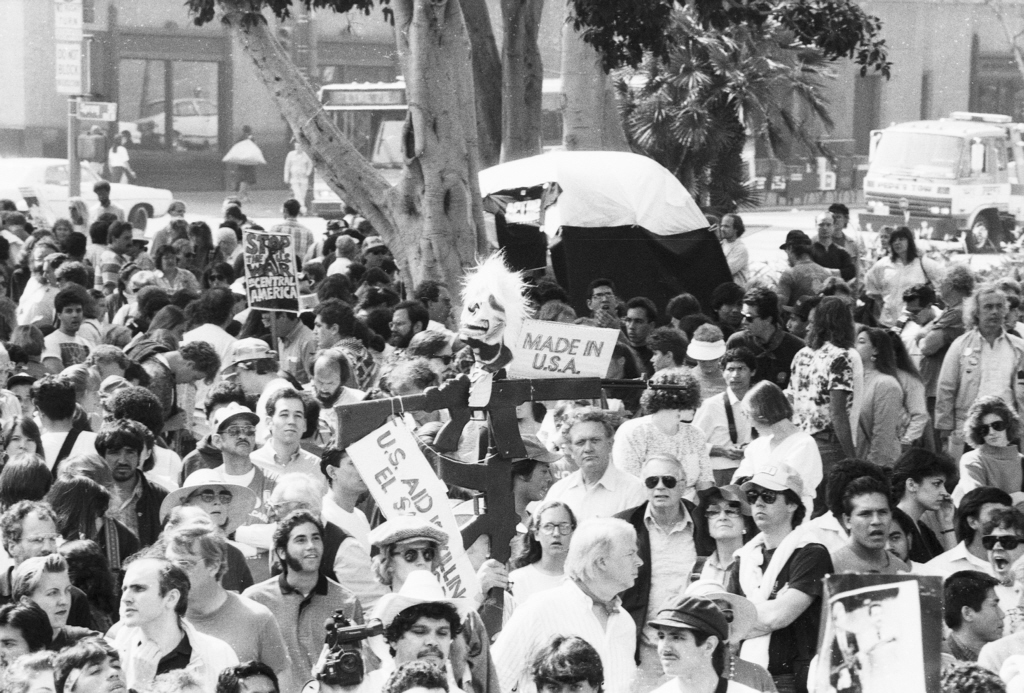
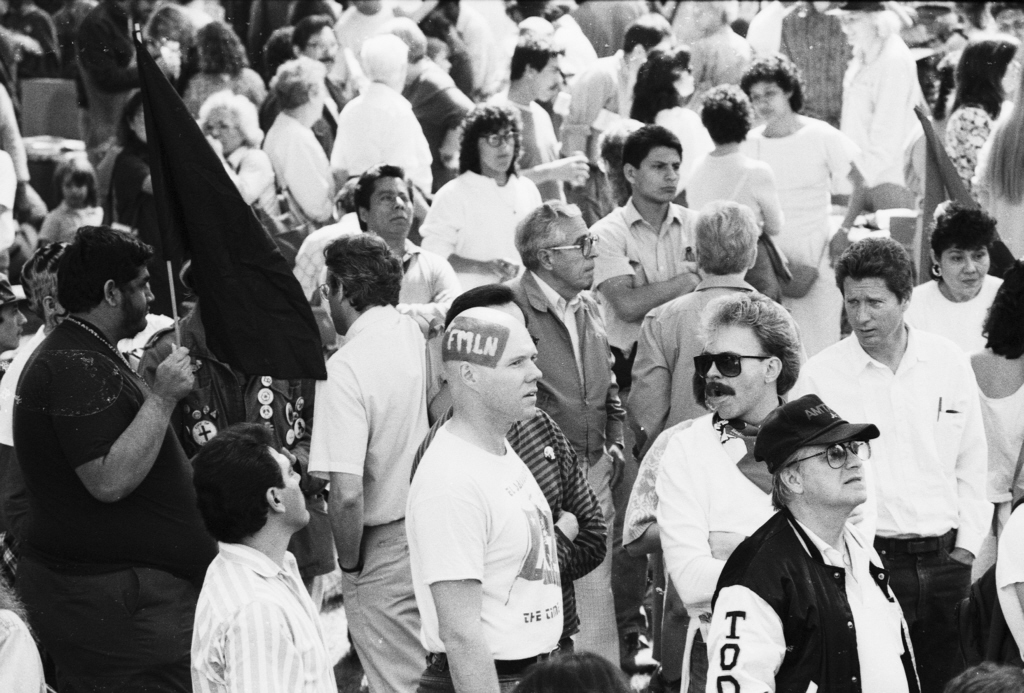
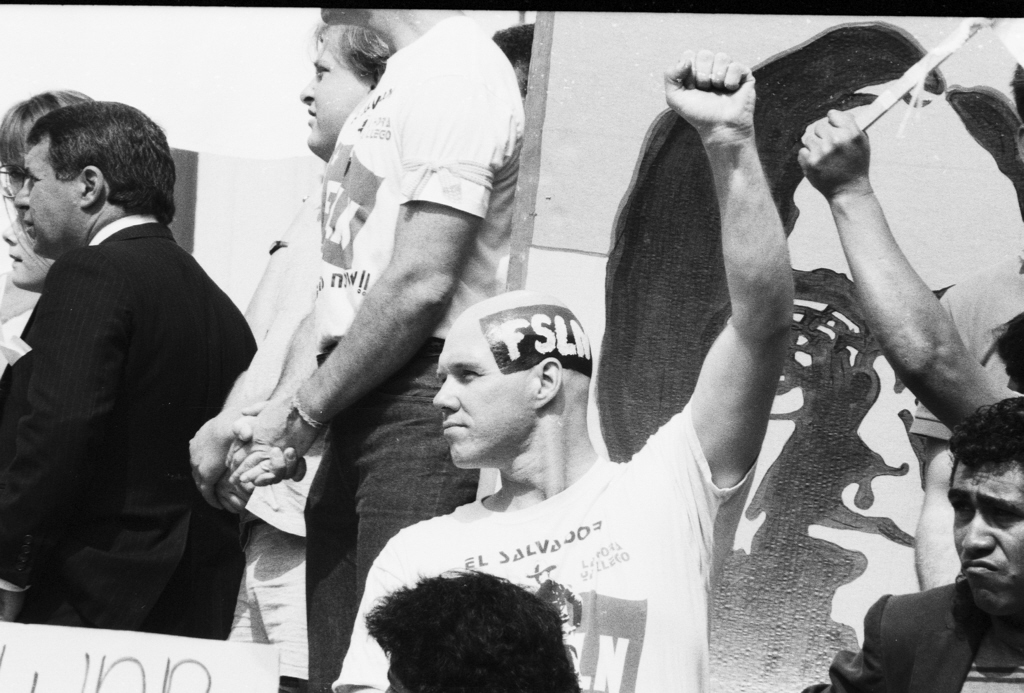
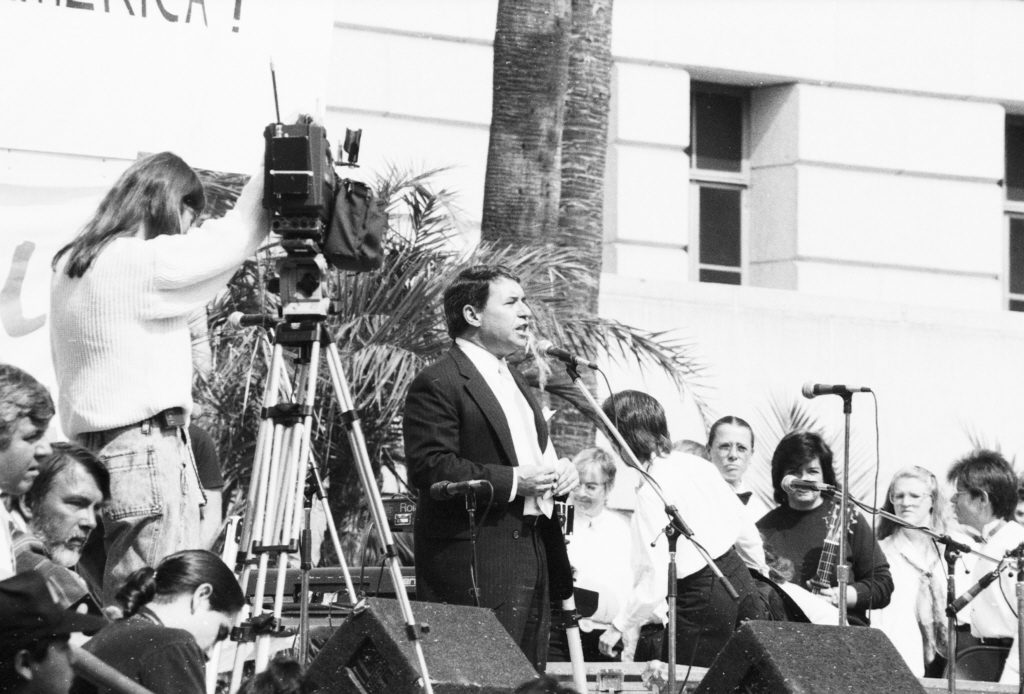
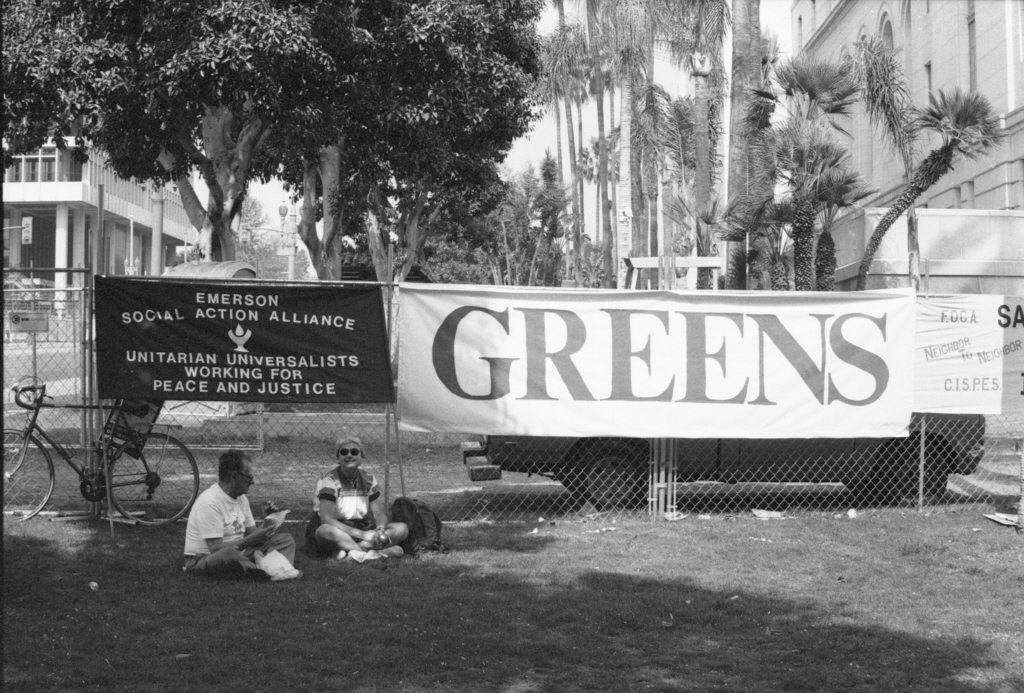 Eddie and Iris Edinger take a break.
Eddie and Iris Edinger take a break.
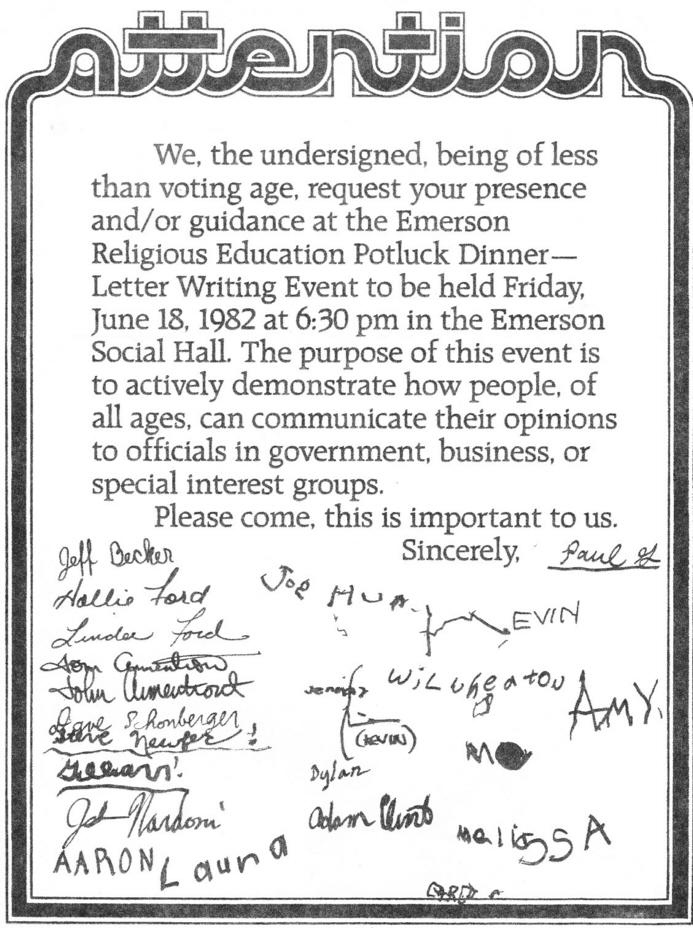 Here the young people in the Emerson Unitarian Universalist Church Sunday school program ask for participation in some letter-writing
that will take place at an RE pot-luck.
Here the young people in the Emerson Unitarian Universalist Church Sunday school program ask for participation in some letter-writing
that will take place at an RE pot-luck. 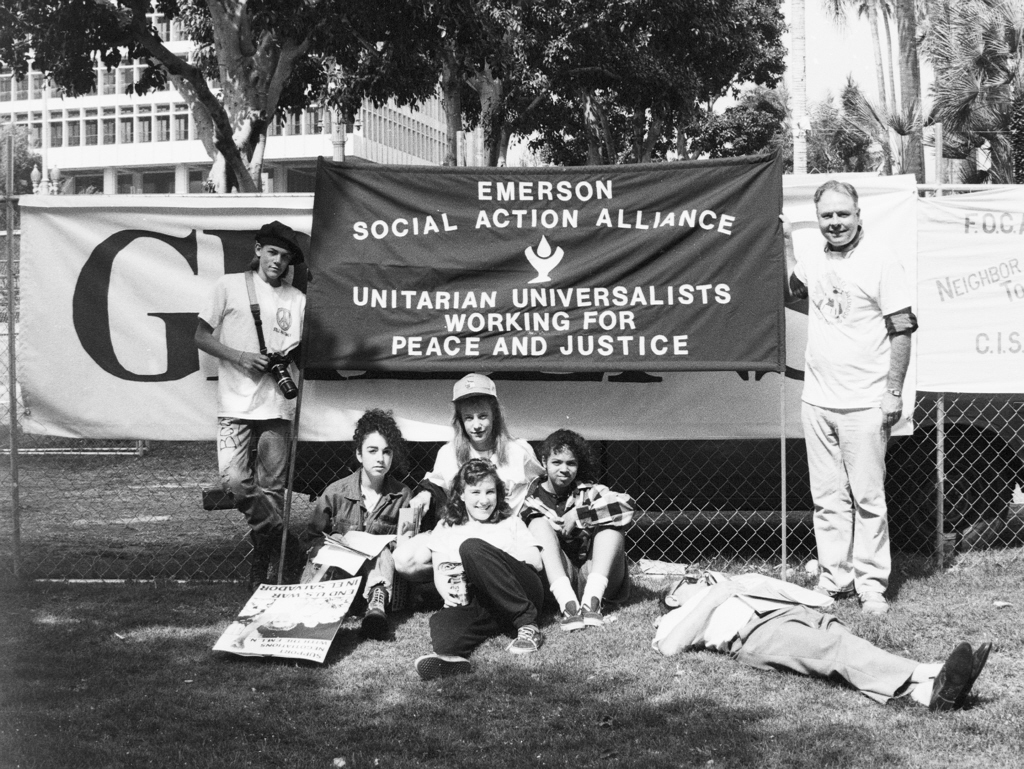 Among the Emerson youth who also marched in the demonstration are David Sanford, holding the banner on the left, and
Laura Clint in the baseball cap. Laura's father Gordon Clint holds the banner at right, and Eddie Edinger takes a nap on the grass.
I don't have the names of the other young people.
Among the Emerson youth who also marched in the demonstration are David Sanford, holding the banner on the left, and
Laura Clint in the baseball cap. Laura's father Gordon Clint holds the banner at right, and Eddie Edinger takes a nap on the grass.
I don't have the names of the other young people.
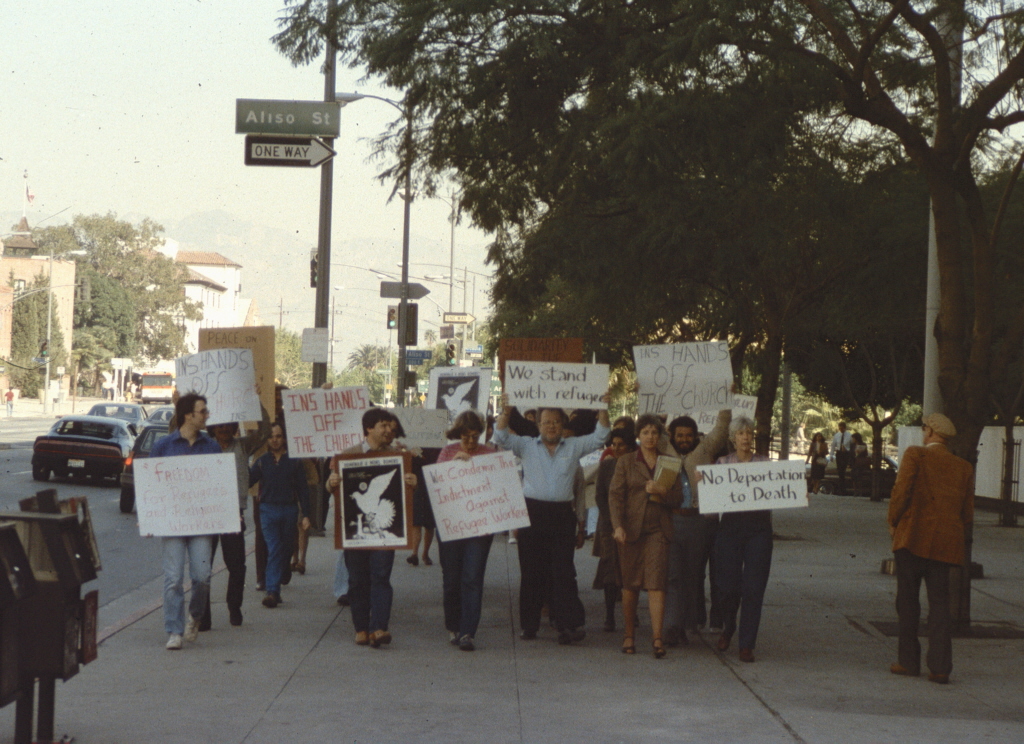 A demonstration in support of Salvadoran and Guatemalan refugees who had fled their countries because their political activity
or associations made their assassinations at the hands of death squads a virtual certainty. All of the death squads in these two
countries enjoyed the tacit approval of the Reagan administration — and tacit funding from the U.S. largess showered on
their repressive military establishments. (This was Republican "trickle down" economics with a vengeance.)
A demonstration in support of Salvadoran and Guatemalan refugees who had fled their countries because their political activity
or associations made their assassinations at the hands of death squads a virtual certainty. All of the death squads in these two
countries enjoyed the tacit approval of the Reagan administration — and tacit funding from the U.S. largess showered on
their repressive military establishments. (This was Republican "trickle down" economics with a vengeance.) 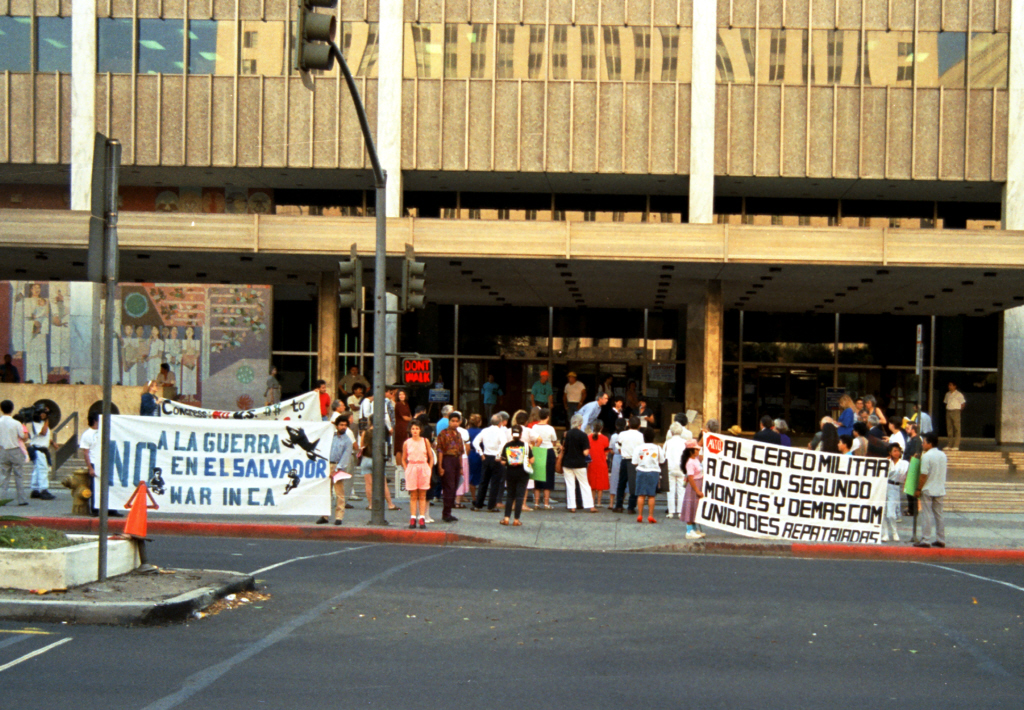 The Federal Building, North Los Angeles Street. Site of many anti-intervention demonstrations. Date unknown,
but almost certainly during the sanctuary movement. I'm pretty sure that this demonstration was organized by the Southern
California Interfaith Taskforce on Central America. SCITCA was a very active anti-intervention group made up of a consortium
of Los Angeles area churches. I believe it held its 'disbandment' dinner sometime in 1993.
The Federal Building, North Los Angeles Street. Site of many anti-intervention demonstrations. Date unknown,
but almost certainly during the sanctuary movement. I'm pretty sure that this demonstration was organized by the Southern
California Interfaith Taskforce on Central America. SCITCA was a very active anti-intervention group made up of a consortium
of Los Angeles area churches. I believe it held its 'disbandment' dinner sometime in 1993.
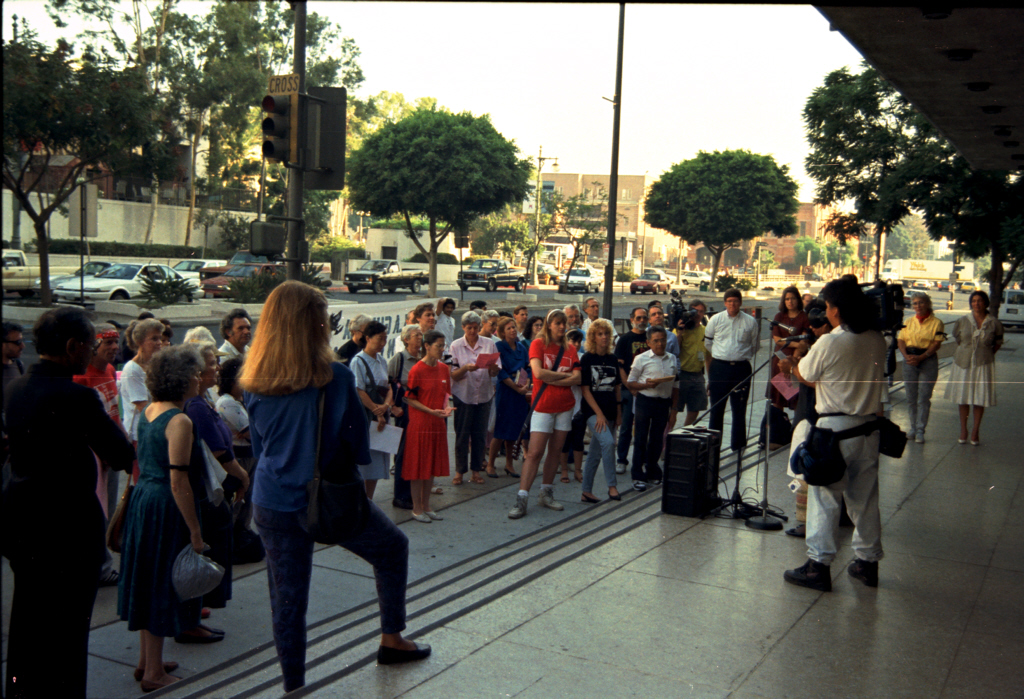 Looking north. I believe that the man standing right center, in the white shirt with the black armband
is my good friend Mike Emery, with whom I shared rice and beans since 1974, when we worked in support of the
United Farm Workers Union; then later on the
Looking north. I believe that the man standing right center, in the white shirt with the black armband
is my good friend Mike Emery, with whom I shared rice and beans since 1974, when we worked in support of the
United Farm Workers Union; then later on the 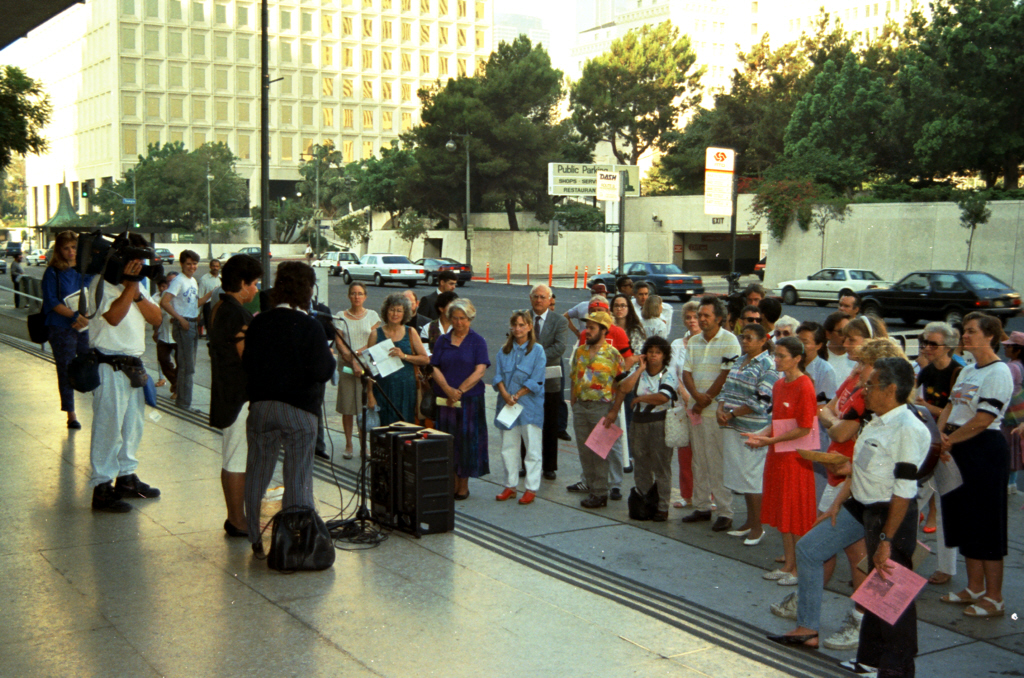 Looking south. City Hall East, in the background, is where I worked from 1979 to 1997. Every day I
drove in and out of the parking entrance visible center.
Looking south. City Hall East, in the background, is where I worked from 1979 to 1997. Every day I
drove in and out of the parking entrance visible center.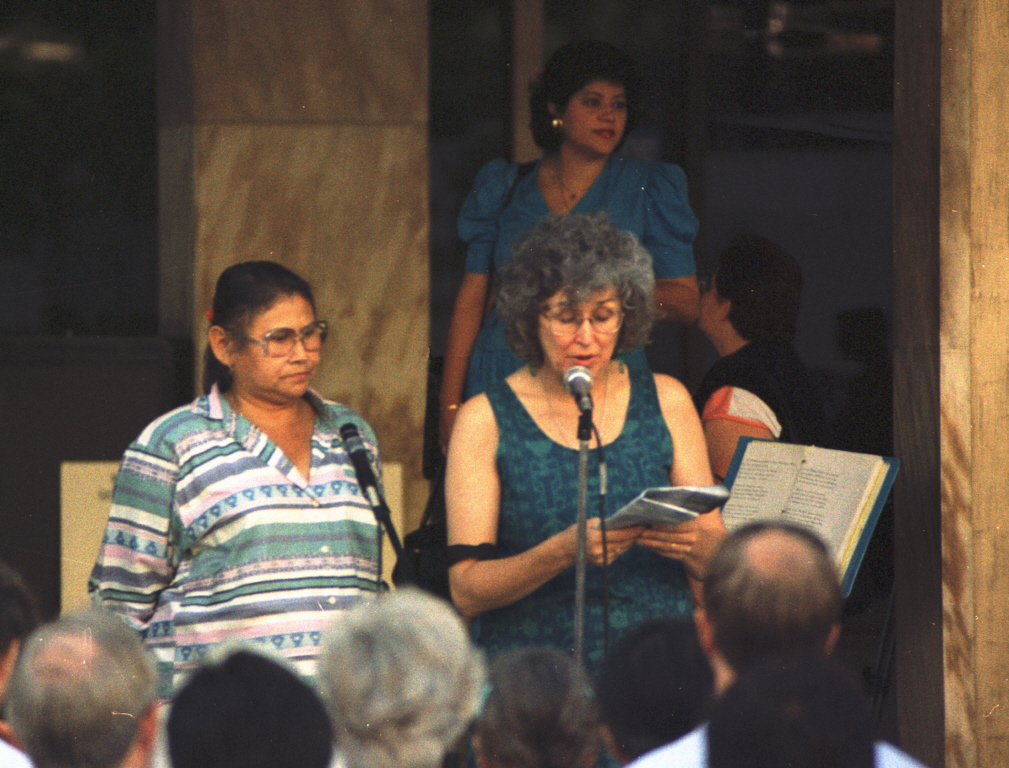 SCITCA's Freddie Schroeder speaks. I do not have the name of the woman behind her, who I am sure is a refugee from El Salvador.
SCITCA's Freddie Schroeder speaks. I do not have the name of the woman behind her, who I am sure is a refugee from El Salvador.
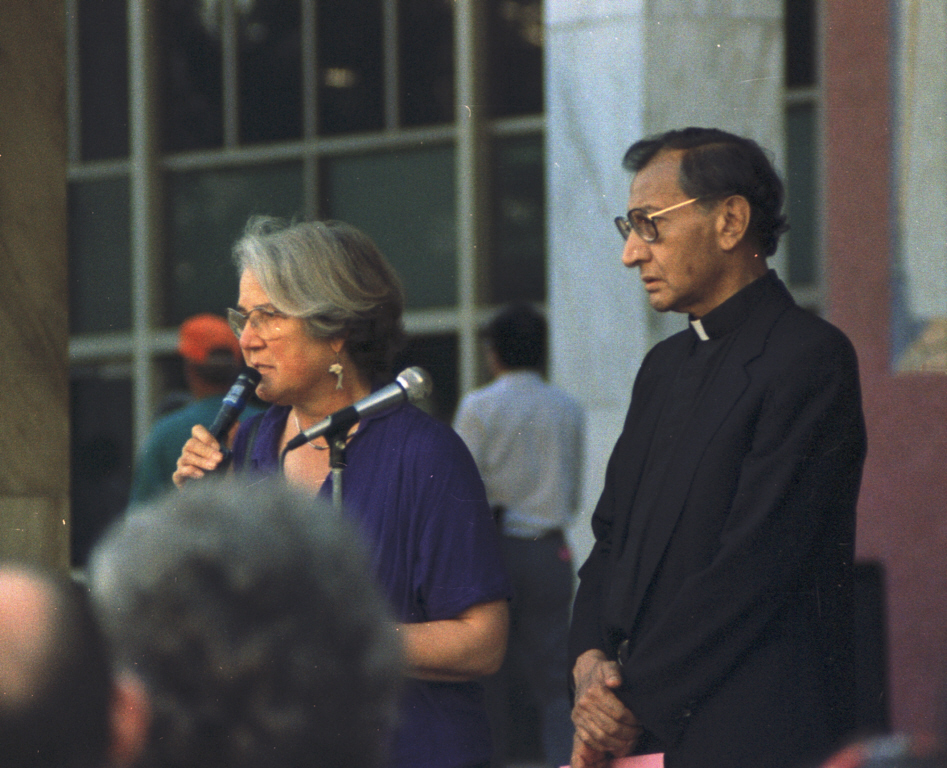 Sister Patricia Krommer speaks, as Father Luis Olivares waits his turn. Father Olivares was the
Pastor of La Placita (Mother Church of Los Angeles, Nuestra Senora Reina de Los Angeles).
Sister Patricia Krommer speaks, as Father Luis Olivares waits his turn. Father Olivares was the
Pastor of La Placita (Mother Church of Los Angeles, Nuestra Senora Reina de Los Angeles). 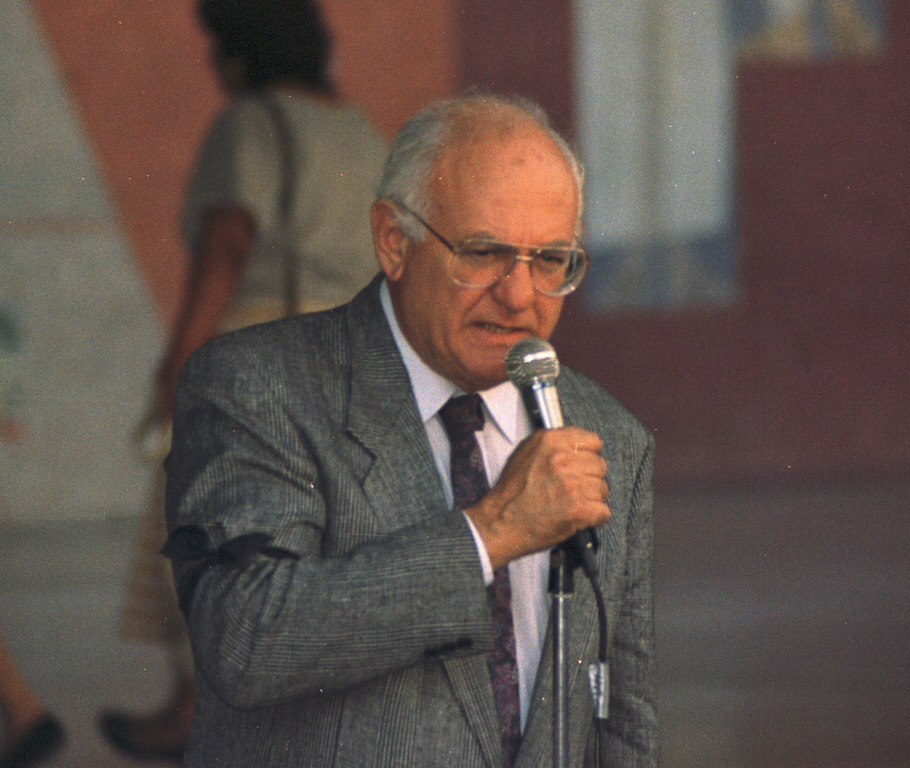 Blase Bonpane, Director of the
Blase Bonpane, Director of the 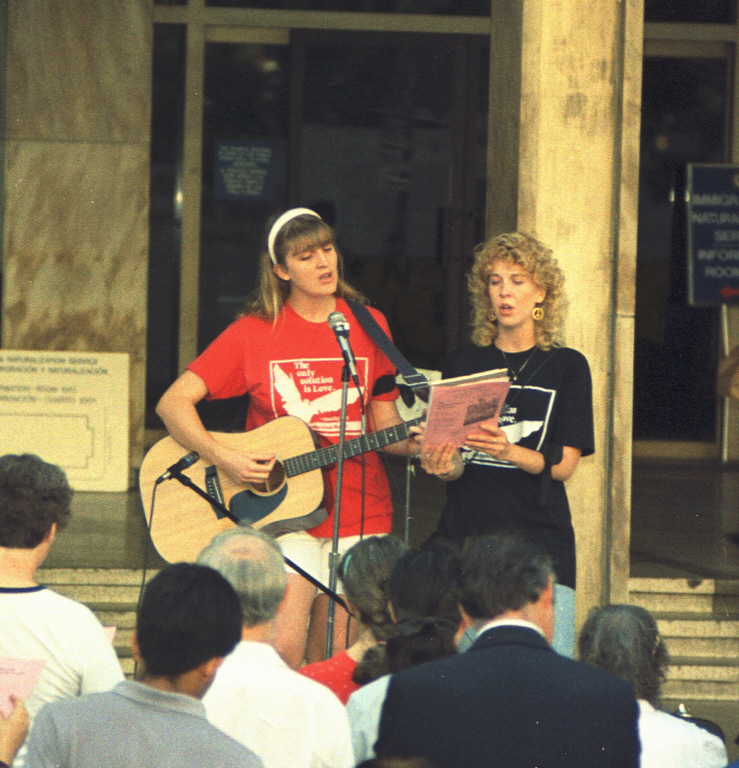
 Fall, 1986.
Emerson Unitarian Universalist Church member Carroll Trumbull, and UUSC staffer Fiona Knox in front of the Federal Building,
downtown Los Angeles. I doubt that here they were part of the large demonstration of November 1, as shown in the following photos.
Fall, 1986.
Emerson Unitarian Universalist Church member Carroll Trumbull, and UUSC staffer Fiona Knox in front of the Federal Building,
downtown Los Angeles. I doubt that here they were part of the large demonstration of November 1, as shown in the following photos.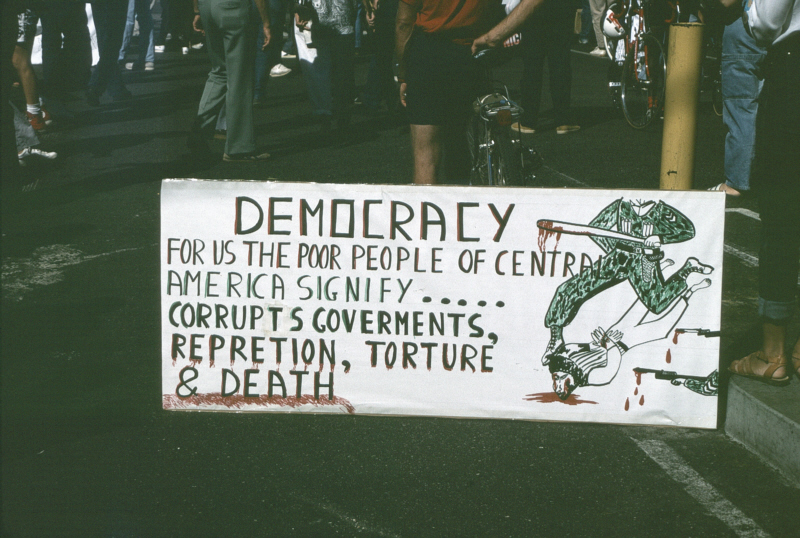
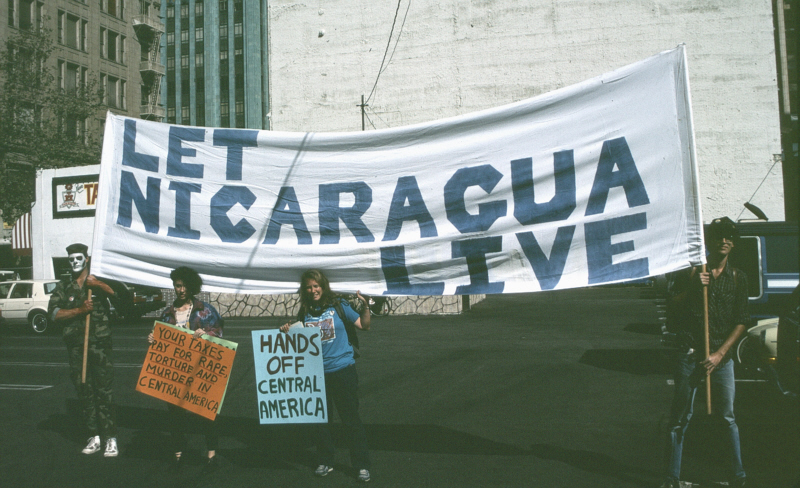
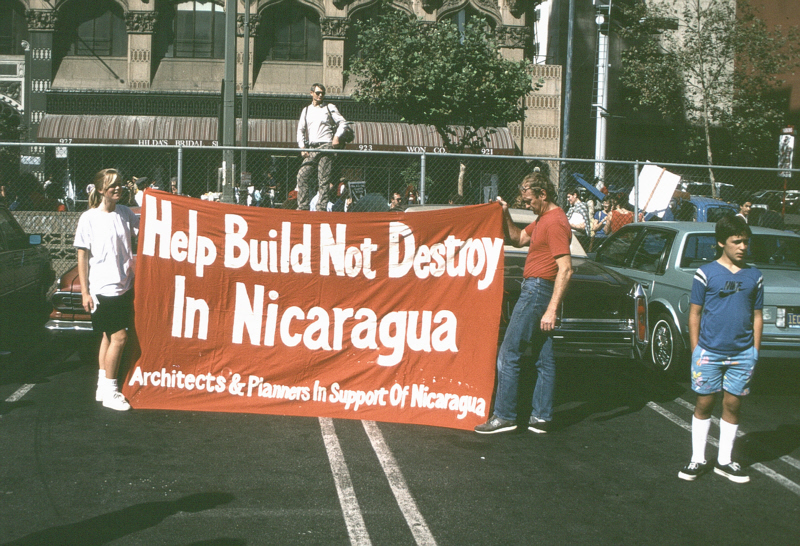
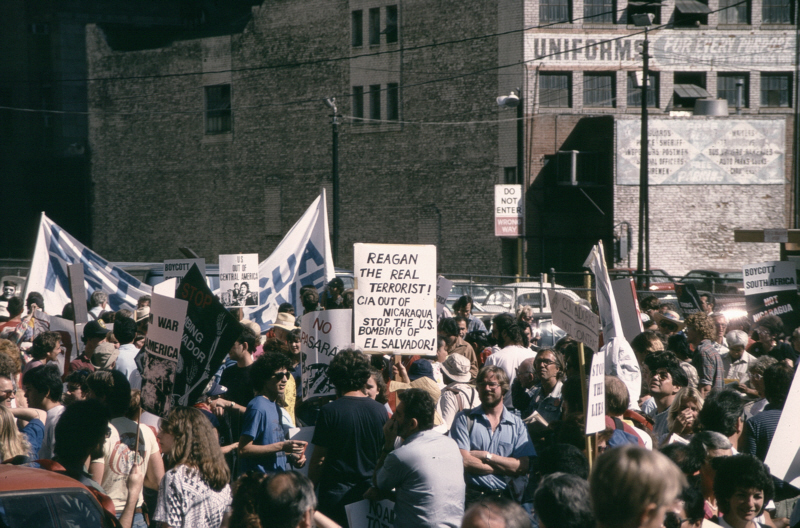
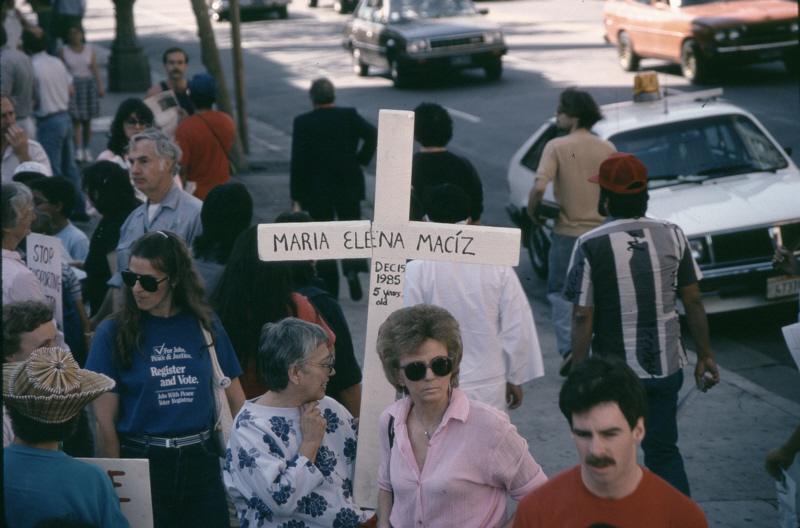
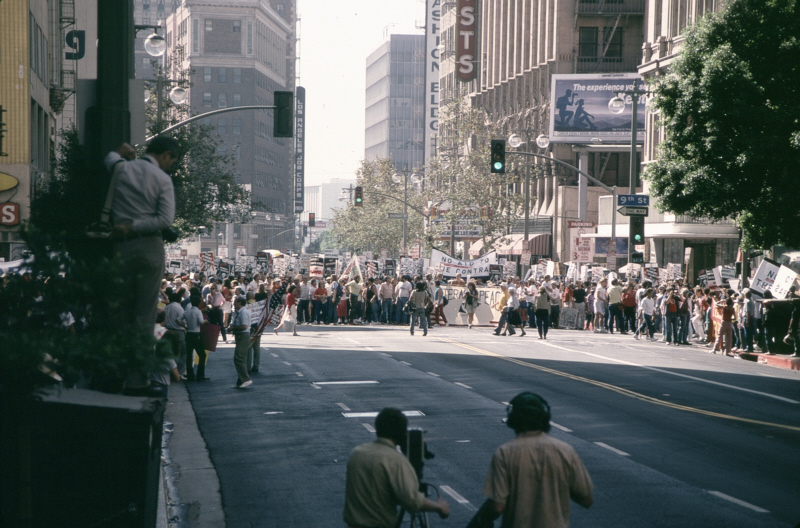
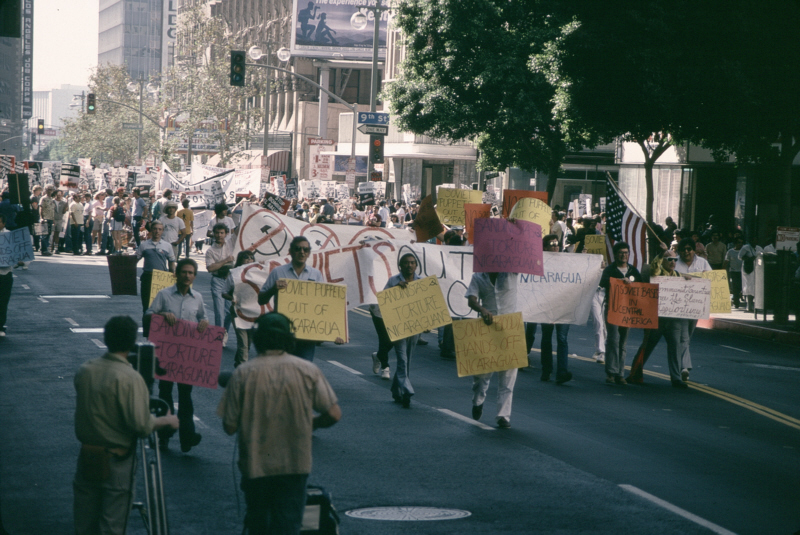 A counter demonstration. My best guess is that the rather few members of this group were
either Cubans or anti-Sandinista Nicaraguans.
A counter demonstration. My best guess is that the rather few members of this group were
either Cubans or anti-Sandinista Nicaraguans.
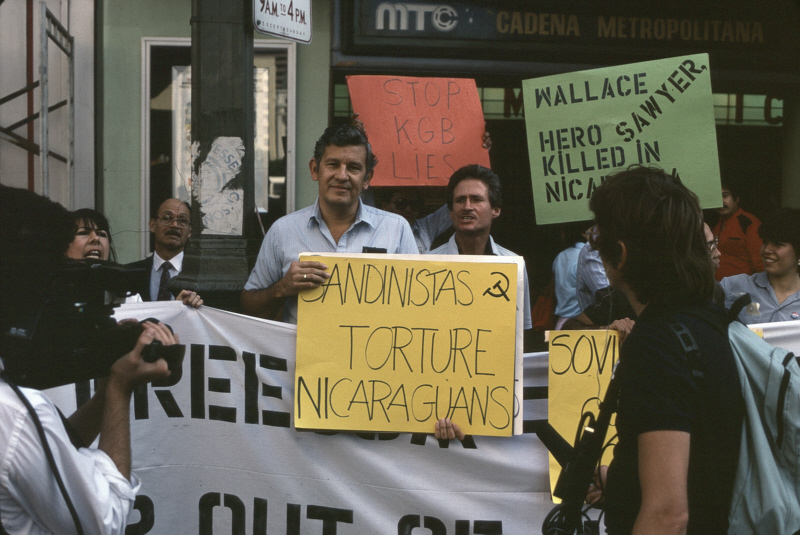
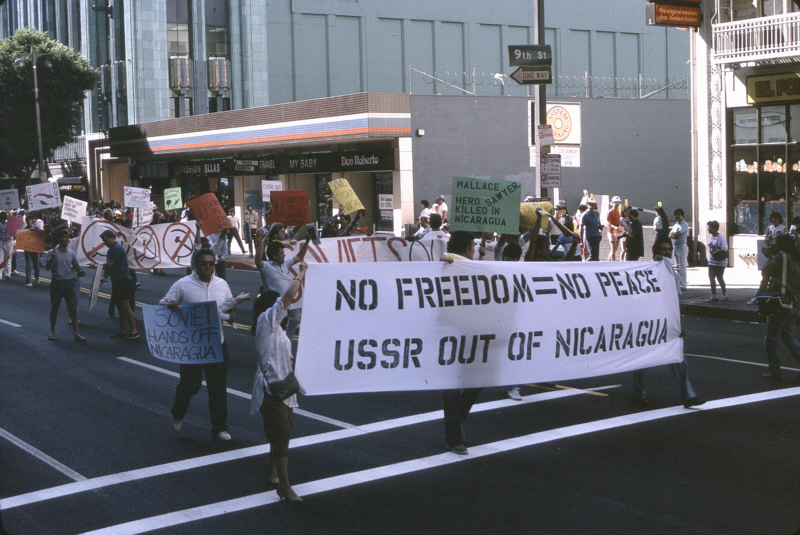
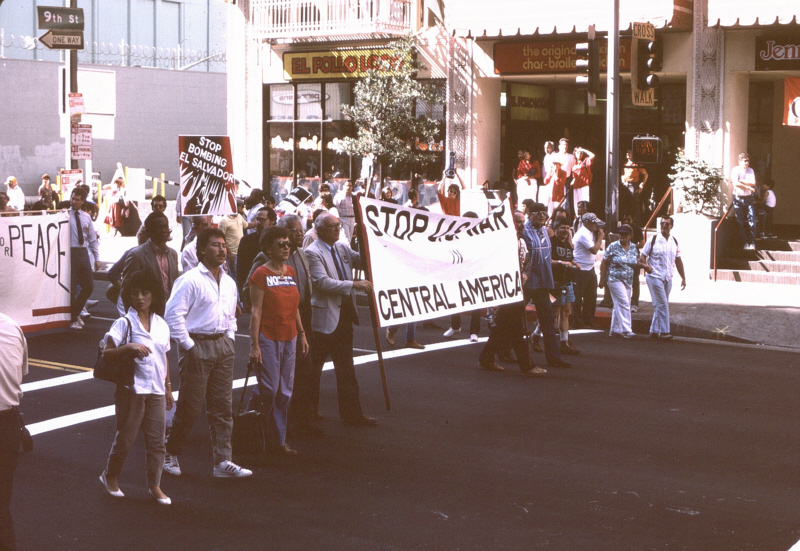
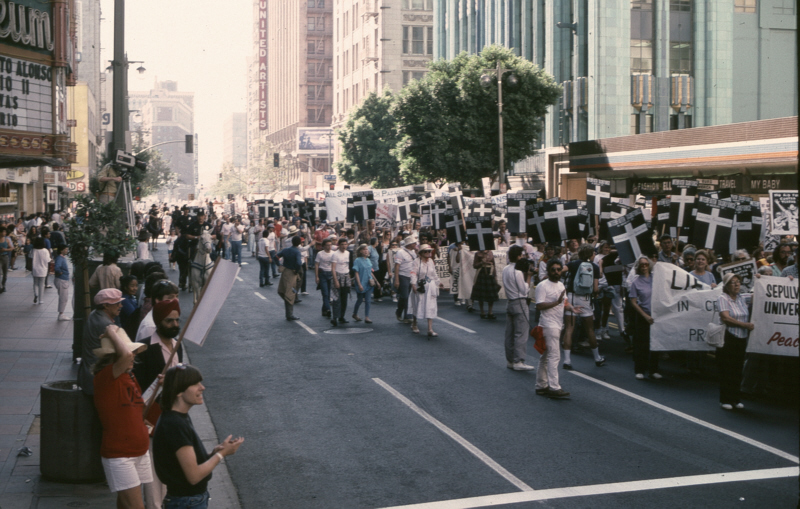
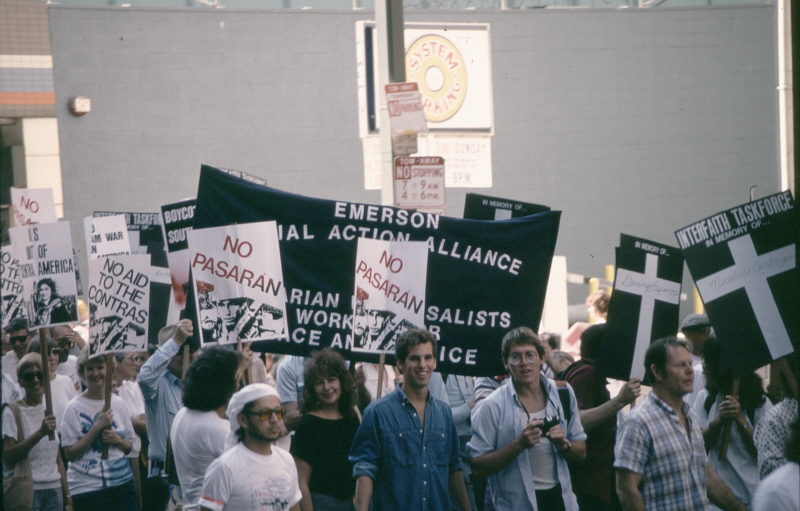 Several marchers smile for the camera, including Bonnie Norwood and Jane Moore to the
left of the ESAA banner.
Several marchers smile for the camera, including Bonnie Norwood and Jane Moore to the
left of the ESAA banner.
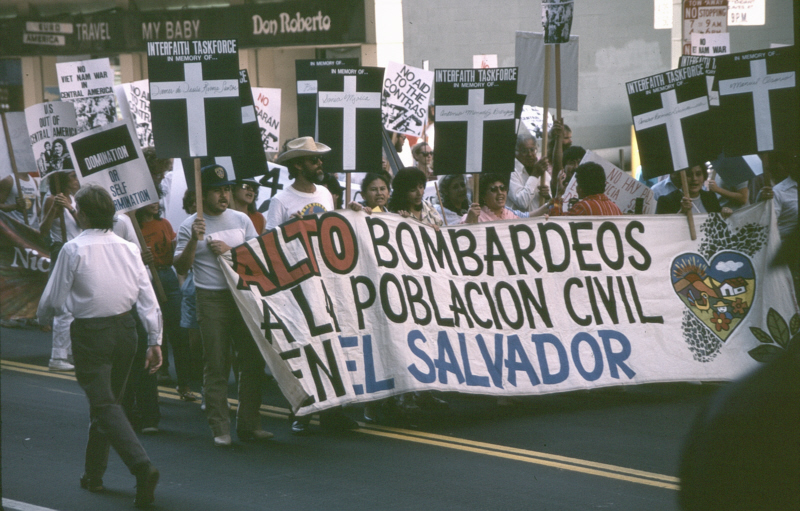
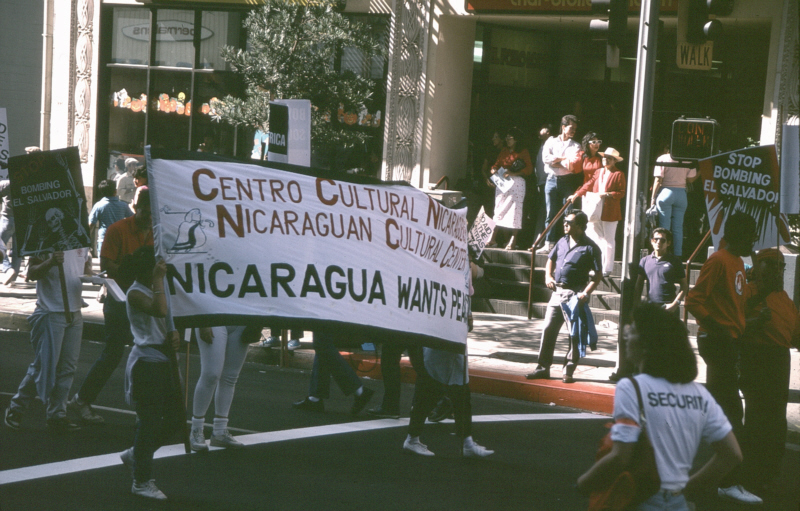
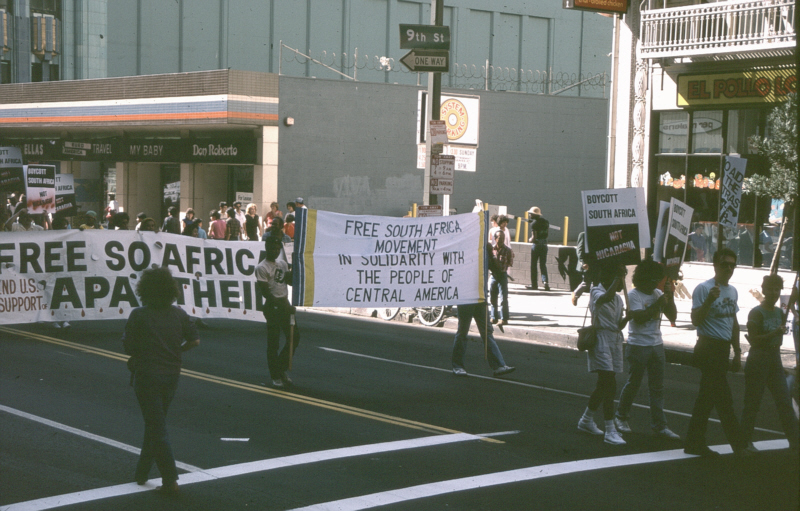
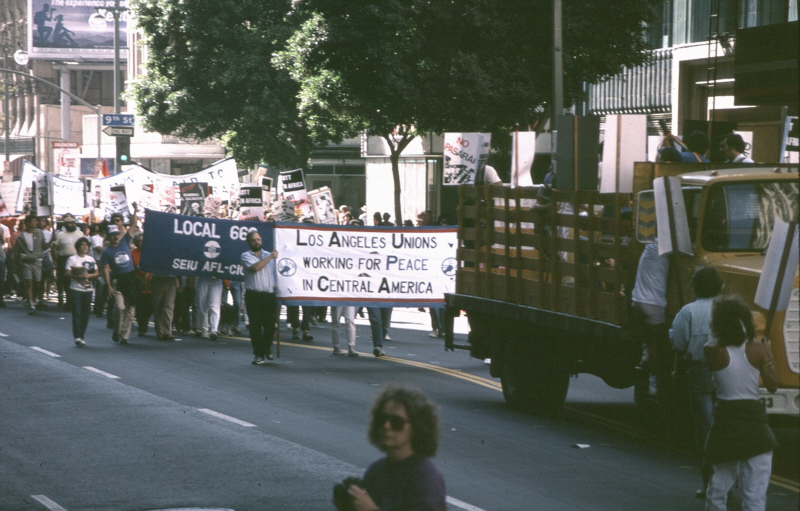
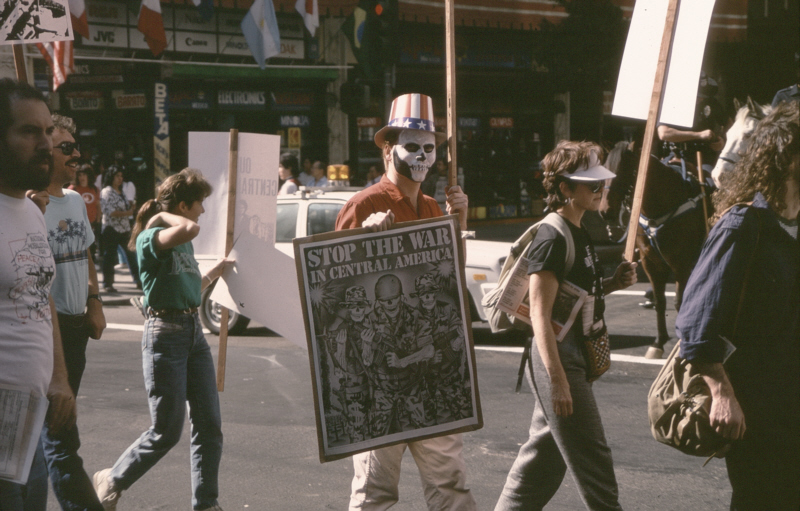 This demonstrator was my favorite. I hope he sees himself here someday.
This demonstrator was my favorite. I hope he sees himself here someday.
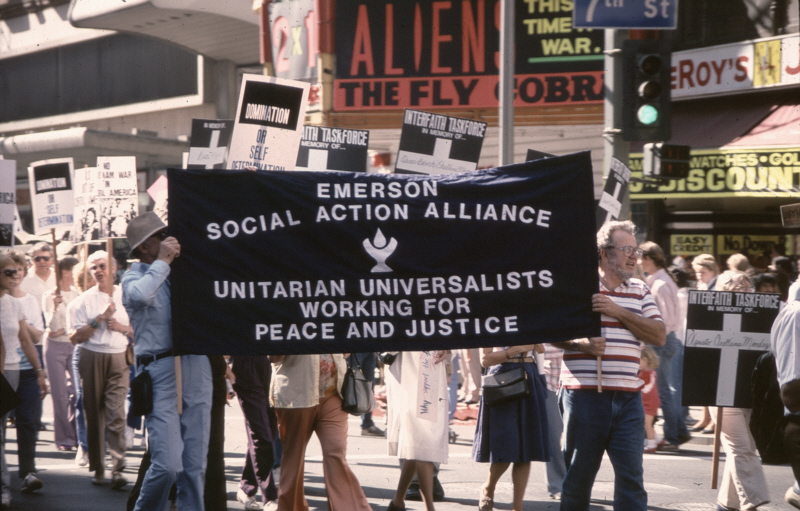 Jack Byrom and Chuck Moore carry the Emerson Social Action Alliance banner.
Jack Byrom and Chuck Moore carry the Emerson Social Action Alliance banner.
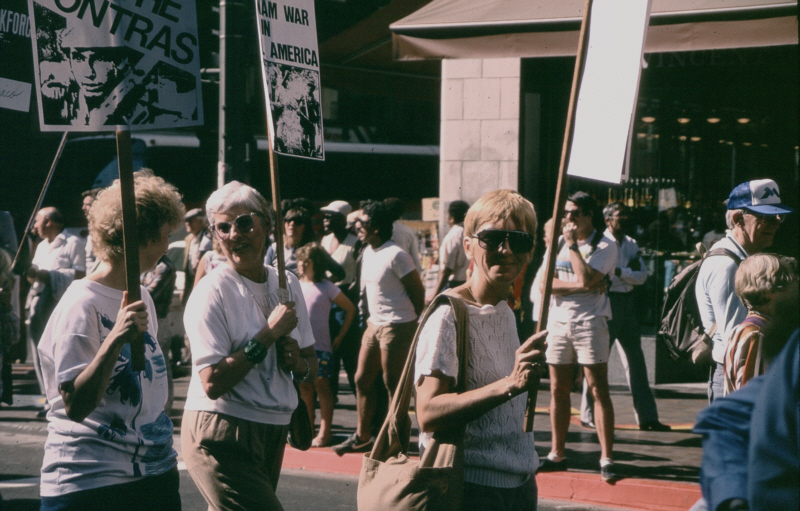 Emerson UU Church members Jane Moore, Bess Byrom, and Bonnie Norwood walk behind the ESAA banner.
Emerson UU Church members Jane Moore, Bess Byrom, and Bonnie Norwood walk behind the ESAA banner.
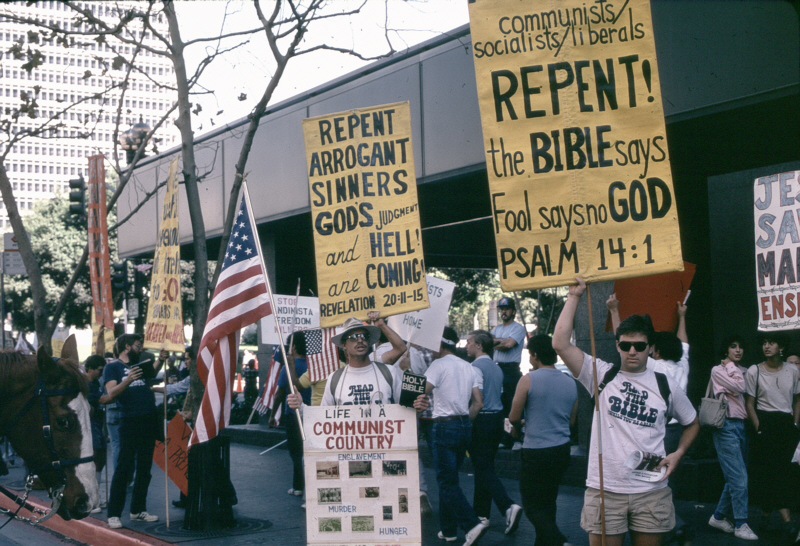 These Christian counter-demonstrators seem to be a different group than those shown above. I appreciate the overt identification
of liberalism with sin. Most right-wing Christians will not say to a liberal's face that he or she is thereby a sinner,
but these guys are honest to a fault.
These Christian counter-demonstrators seem to be a different group than those shown above. I appreciate the overt identification
of liberalism with sin. Most right-wing Christians will not say to a liberal's face that he or she is thereby a sinner,
but these guys are honest to a fault.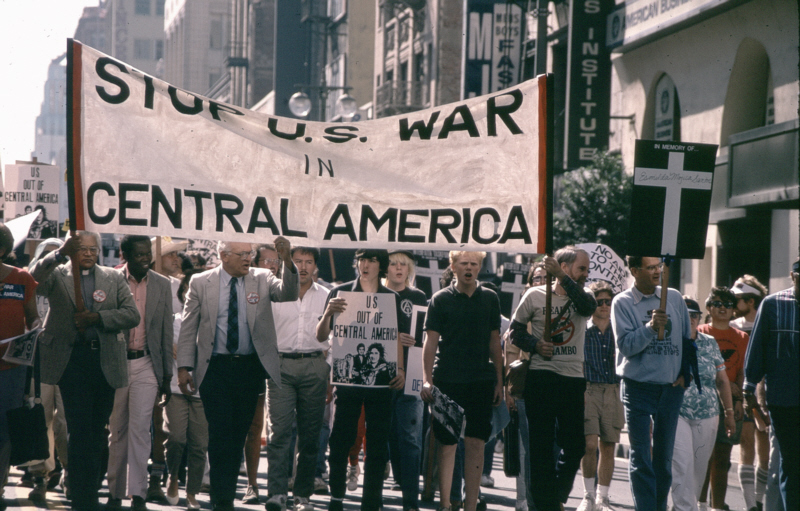 Reverend James Lawson, Blase Bonpane, and Charlie Clements have been joined by Vietnam veteran and Medal of
Honor winner Charles Liteky (blue sweatshirt). Two weeks earlier, Liteky and three other veterans ended
their
Reverend James Lawson, Blase Bonpane, and Charlie Clements have been joined by Vietnam veteran and Medal of
Honor winner Charles Liteky (blue sweatshirt). Two weeks earlier, Liteky and three other veterans ended
their 